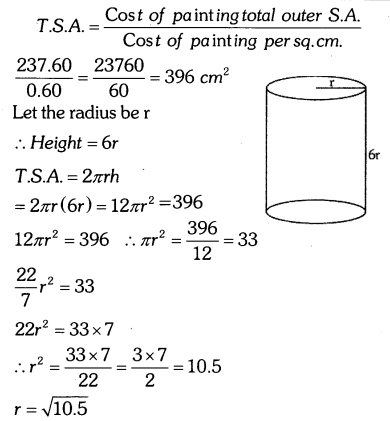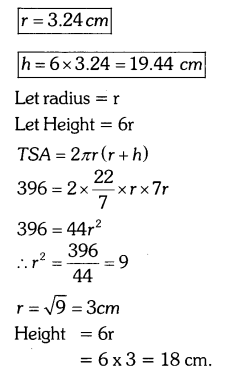Students can Download Karnataka SSLC Maths Model Question Paper 6 with Answers (Old Pattern), Karnataka SSLC Maths Model Question Papers with Answers helps you to revise the complete Karnataka State Board Syllabus and score more marks in your examinations.
Karnataka State Syllabus SSLC Maths Model Question Paper 1 (Old Pattern)
Time: 3 Hours
Max Marks: 80
I. In the following questions, four choices are given for each question, choose and write the correct answer along with its alphabet: ( 1 × 8 = 8 )
Four alternatives are given to each question. Choose an appropriate answer. Write it along with its alphabet.
(8 × 1 = 8)
Question 1.
The distance between two points p(x1, y1) and q (x2, y2) is given by

Question 2.
The degree of polynomial p(x) = x2 – 3x + 4x3 – 6 is
(A) 2
(B) 1
(C) 3
(D) 6
Question 3.
Which one of the following cannot be the probability of an event?
(A) \(\frac { 2 }{ 3 }\)
(B) -1.5
(C) 15%
(D) 0.7
![]()
Question 4.
The curved surface area of frustum of a cone is given by
(A) Π (r1 + r2) l
(B) Π (r1 + r2) h
(C) Π (r1 – r2) l
(D) Π (r1 – r2) h
Question 5.
The solutions for the equations x + y = 10 and x – y = 2 are
(A) x = 6, y = 4
(B) x = 4, y = 6
(C) x = 7, y = 3
(D) x = 8, y = 2
Question 6.
In the adjoining figure, TP and TQ are the tangents to the circle with centre O. The measure of ∠PTQ is
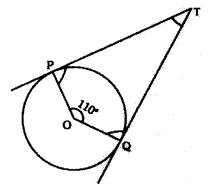
(A) 90°
(C) 70°
(B) 110°
(D) 40°
Question 7.
The coordinates of origin are
(A) (1, 1)
(B) (2, 2)
(C) (0, 0)
(D) (3, 3)
Question 8.
If the discriminant of quadratic equation b2 – 4ac = 0 then the roots are
(A) Real and distinct
(B) Roots are equal
(C) No Real Roots
(D) Roots are unequal and irrational
(6 × 1 = 6)
Question 9.
State “Basic proportionality theorem”.
Question 10.
Identify the tangent to the circle in the adjoining figure and write its name.

Question 11.
State Euclid’s division lemma.
Question 12.
Find the number of zeroes of a polynomial p(x) from the graph given
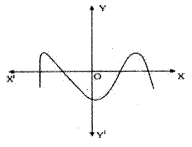
Question 13.
Find the distance of the point p(3, 4) from the origin.
![]()
Question 14.
Express 140 as a product of prime factors.
(16 × 2 = 32)
Question 15.
How many two – digit numbers are divisible by 3?
Question 16.
∆ABC ~ ∆DEF , Area of ∆ABC = 64cm2 and area of ∆DEF = 121cm2. If EF = 15.4 cm, Find BC.
Question 17.
Solve for x and y : 2x + y = 6 and 2x – y = 2.
Question 18.
Five years ago, Gouri was thrice as old as Ganesh. Ten years later Gouri will be twice as old as Ganesh. How old are Gouri and Ganesh?
Question 19.
Find the area of the shaded region in the figure, where ABCD is a square of side 14 cm.
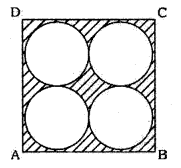
Question 20.
Construct a pair of tangents to a circle of radius 5 cm Which are inclined to each other at an angle of 60°.
Question 21.
Find the value of k, if the points A (2, 3), B(4, k) and C (6, -3) are collinear.
Question 22.
Prove 3 + √5 is irrational.
Question 23.
Find the zeroes of polynomial p(x) = 6x2 – 3 – 7x.
Question 24.
Find the quadratic polynomial whose sum and product of zeroes are \(\frac { 1 }{ 4 }\) and -1 respectively.
Question 25.
Solve the equation 3x2 – 5x + 2 = 0 by using the formula.
Question 26.
Evaluate : 2 tan2 45° + cos2 30° = sin2 60°
Question 27.
The angle of elevation of the top of a tower from a point on the ground, which is 30 m away from the foot of the tower is 30°, Find the height of the tower.
Question 28.
As observed from the top of a 100 m high lighthouse from the sea level the angle of depression of two ships are 30° and 45°. If one of the ships is exactly behind the other on the same side of the lighthouse, find the distance between the two ships (√3 = 1.73)
Question 29.
A die is thrown once. Find the probability of getting a number between 2 and 6.
Question 30.
The volume of a cube is 64 cm2. Find the total surface area of the cube.
(6 × 3 = 18)
Question 31.
Prove that “The tangent at any point of a circle is perpendicular to the radius through the point of contact”.
OR
Prove that “The lengths of tangents drawn from an external point to a circle are equal”.
Question 32.
Construct a triangle of sides 4 cm, 5 cm and 6 cm and then a triangle similar to it, whose sides are \(\frac { 2 }{ 3 }\) of the corresponding sides of the first triangle.
Question 33.
A two digit number is four times the sum of the digits. It is also equal to 3 times the product of digits. Find the number.
OR
The numerator of a fraction is 3 less than its denominator. If 2 is added to both the numerator and the denominator, then the sum of the new fraction and the original fraction is \(\frac { 29 }{ 20 }\) Find the original fraction.
Question 34.
If 4tanθ = 3, Evaluate \(\frac { 4sin\theta -cos\theta +1 }{ 4sin\theta +cos\theta -1 }\)
OR
If tan 2A = cot (A – 18°) where 2A is an acute angle. Find the value of A.
Question 35.
Calculate the median for the following data.
| Class interval | Frequency (F) |
| 0-20 | 6 |
| 20-40 | 8 |
| 40-60 | 10 |
| 60-80 | 12 |
| 80-100 | 6 |
| 100-120 | 5 |
| 120-140 | 3 |
| n = 50 |
OR
Calculate the mode for the following frequency distribution table
| Class Interval | Frequency (F) |
| 5-15 | 6 |
| 15-25 | 11 |
| 25-35 | 21 |
| 35-45 | 23 |
| 45-55 | 14 |
| 55-65 | 5 |
| n = 80 |
Question 36.
Construct ‘ogive’ for the following construction.
| C31 | 0-3 | 3-6 | 6-9 | 9-12 | 12-15 |
| F | 9 | 3 | 5 | 3 | 1 |
(4 × 4 = 16)
Question 37.
The sum of four consecutive terms which are in an arithmetic progression is 32 and the ratio of the product of the first and the last term in the product of two middle terms is 7.15. Find the number.
OR
In an arithmetic progression of 50 terms, the sum of the first ten terms is 210 and the sum of the last fifteen terms is 2565. Find the arithmetic progression.
Question 38.
Prove that “In a right-angled triangle the square on the hypotenuse is equal to the sum of the square on the other two-siders”.
Question 39.
Solve the equations graphically.
2x – y = 2; 4x – y = 4
Question 40.
A wooden article was made by scooping out a hemisphere from one end of a cylinder and a cone from other ends as shown in the figure. If the height of the cylinder is 40 cm, a radius is 7 cm and height of the cone is 24 cm, find the volume of the wooden article.
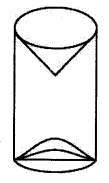
Solutions
Solution 1.
(B) or (D)

Solution 2.
(C) 3
Solution 3.
(B) -1, 5
Solution 4.
(A) Π (r1 + r2) l
Solution 5.
(A) x = 6, y = 4
Solution 6.
(C) 70°
Solution 7.
(C) (0, 0)
Solution 8.
(B) Roots are equal
Solution 9.
If a line is drawn parallel to one side of a triangle, it divides the other two sides proportionally.
Solution 10.
RS
![]()
Solution 11.
Let a and b be any two positive integers.
Then there exist two unique whole nos. q and r such that a = bq + r, (0 ≤ r < b)
Solution 12.
4
Solution 13.

Solution 14.
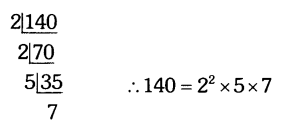
Solution 15.
Nos. divisible by 3 = 12,15,18, 21, …….., 99
a = 12, d = 3, T = 99, n = ?
Tn = a + (n – 1)d
⇒ 99 = 12 + (n – 1) 3
⇒ 99 – 12 = 3n – 3
⇒ 87 + 3 = 3n
⇒ 90 = 3n
⇒ n = 30
30 two digits are divisible by 3.
Solution 16.
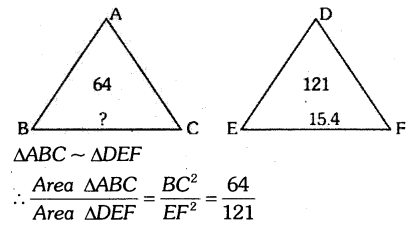
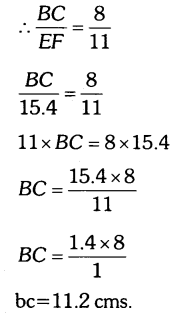
Solution 17.
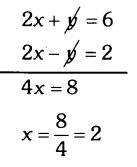
Substitute the value of x in Eqn 1
2x + y = 6
⇒ 2(2) + y = 6
⇒ 4 + y = 6
⇒ y = 6 – 4 = 2
∴ x = 2, y = 2
Solution 18.
Let the age of Gauri be ‘x’ years.
Let the age of Ganesh be ‘y’ years.
5 years ago
(x – 5) = 3(y – 5)
⇒ x – 5 = 3y – 15
⇒ x – 3y = -15 + 5
⇒ x – 3y = -10 …..(1)
10 years later
(x + 10) = 2(y + 10)
⇒ x + 10 = 2y + 20
⇒ x – 2y = 20 – 10
⇒ x – 2y = 10 ……(2)
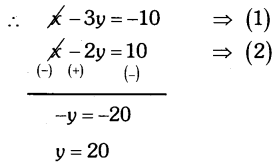
Substitute the value of y in equation 1
x – 3y = -10
⇒ x – 3(20) = -10
⇒ x – 60 = -10
⇒ x = -10 + 60
⇒ x = 50
Gouri’s Age = 50 yrs, Ganesha’s Age = 20 yrs.
![]()
Solution 19.
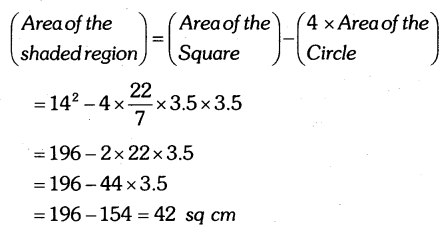
Solution 20.
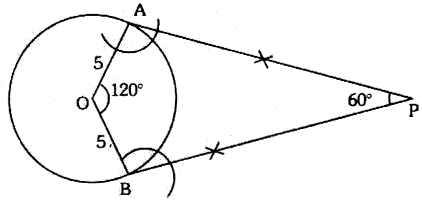
Solution 21.
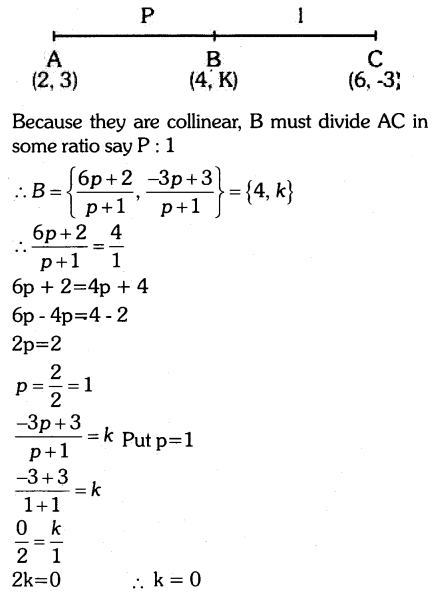
Solution 22.
Let us assume that (3 + √5) is rational
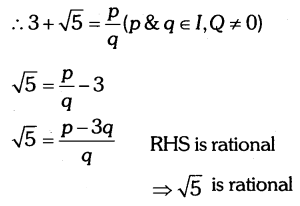
But √5 is irrational
It contradicts the fact that √5 is irrational
our assumption is wrong.
3 + √5 is irrational.
Solution 23.
p(x) = 6x2 – 7x – 3
By splitting the middle term we get
6x2 – 9x + 2x – 3
3x(2x – 3) + 1 (2x – 3)
(2x – 3)(3x + 1)
for zero’s of p(x) put 2x – 3 = 0 & 3x + 1 = 0
1. 2x – 3=0
2x = 3
x = \(\frac { 3 }{ 2 }\)
2. 3x + 1 = 0
3x = -1
x = \(\frac { -1 }{ 3 }\)
Zeros of p(x) are \(\frac { 3 }{ 2 }\) and \(\frac { -1 }{ 3 }\)
Question 24.
The quadratic polynomial is given by
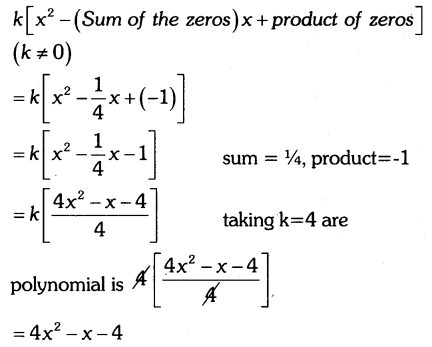
Question 25.
3x2 – 5x + 2 = 0
Compare it with the standard form
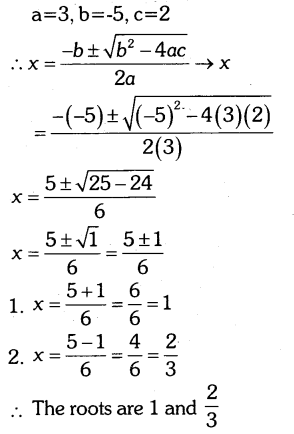
Solution 26.

Solution 27.
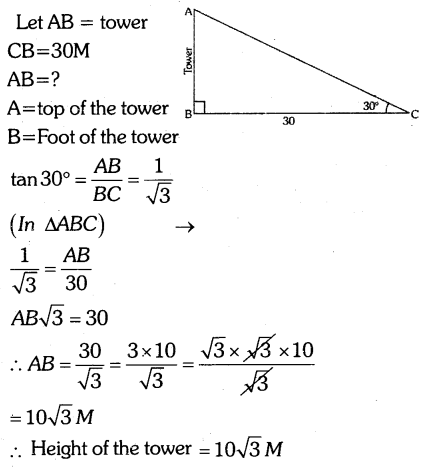
![]()
Solution 28.

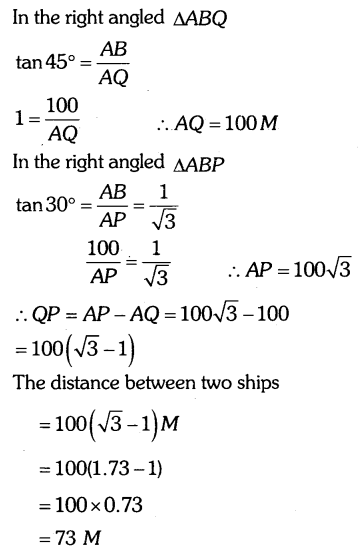
Solution 29.
No. of all possible outcome = {1, 2, 3, 4, 5, 6}
n(S) = 6
Let E be the event of getting a no. between 2 and 6.
No. of favourable outcomes n(E) = {3, 4, 5} = 3
P(E) = \(\frac { n(E) }{ n(S) }\) = \(\frac { 3 }{ 6 }\)
Solution 30.
Volume of the cube = l3
64 = l3
l = 4
T.S.A. of the cube = 6l2 = 6 × 42 = 6 × 16 = 96 Sq.cm.
Solution 31.
Theorem: The tangent at any point of a circle is perpendicular to the radius through the point of contact.
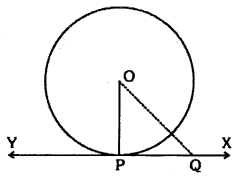
Proof: We are given a circle with centre O a tangent XY to the circle at a point R We need to prove that OP is perpendicular to XY.
Take a point Q on XY other the P and join OQ see in below fig.
The point Q must lie outside the circle. (Why? Note that if Q lies inside the circle XY will become a secant and not a tangent to the circle). Therefore OQ is longer than the radius OP of the circle. That is,
OQ > OR
Since this happens for every point on the line XY except the point R OP is the shortest of all the distances of the point O to the points of XY. So OP is perpendicular to XY. (as shown in theorem).
OR
Theorem: The lengths of tangents drawn from an external point to a circle are equal.
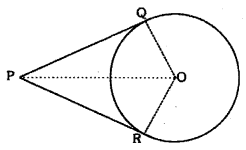
Proof: We are given a circle with centre O, a point P lying outside the circle and two tangents PQ, PR on the circle from P (see in fig.). We are required to prove that PQ = PR,
For this, we join OR OQ and OR. Then ∠OQP and ∠ORP are right angles because these are angles between the radii and tangents, and according to the theorem, they are right angles.
Now in right triangles OQP and ORP
OQ = OR (Radii of the same circle)
OP = OP (Common)
Therefore, ΔOQP = ΔORP (RHS)
This gives PQ = PR
Solution 32.

Steps of construction:
- Draw BC = 6 cm.
- With B as the centre & radius 4 cms. draw an arc.
- With C as centre and radius, 5 cm cut the first arc at A
- Join AB and AC to get ΔABC
- Draw any ray BX below BC making an acute angle with BC.
- Locate 3 points B1, B2, B3 as BX such that BB1 = B1B2 = B2B3
- Join B3C
- Draw a line through B2 parallel to B3C intersecting BC at C’
- Draw a line through C’ parallel to AC to intersect BA at A’
- Now A’BC’ is the required Δ each of whose sides is \(\frac { 2 }{ 3 }\) of the corresponding sides of ΔABC
Solution 33.
Set the no. be xy.
10x + y = 4(x + y)
10x + y = 4x + 4y
10x – 4x = 4y – y
2x = y
10x + y = 3xy
10x + 2x = 3x(2x)
12x = 6×2
12 = 6x
x = 2
y = 2 × 2 = 4
No. = 24
OR
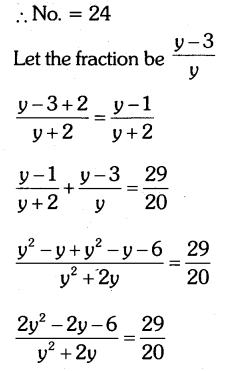
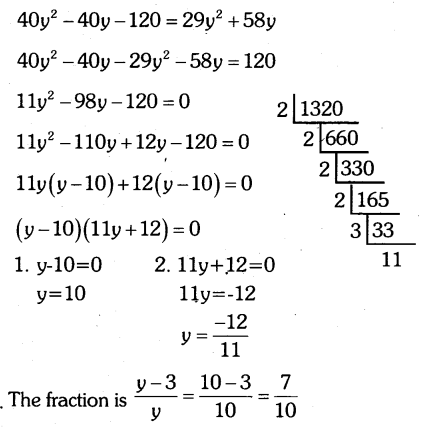
Solution 34.
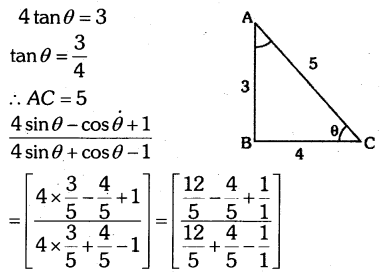
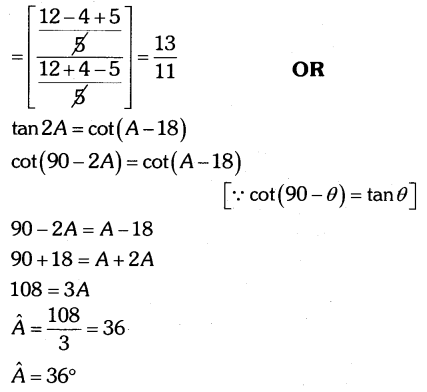
Solution 35.
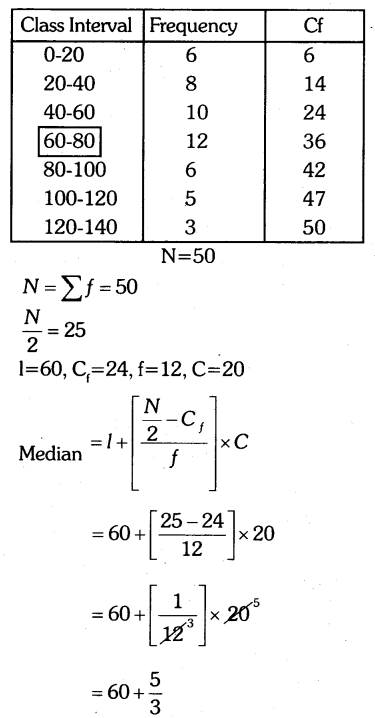
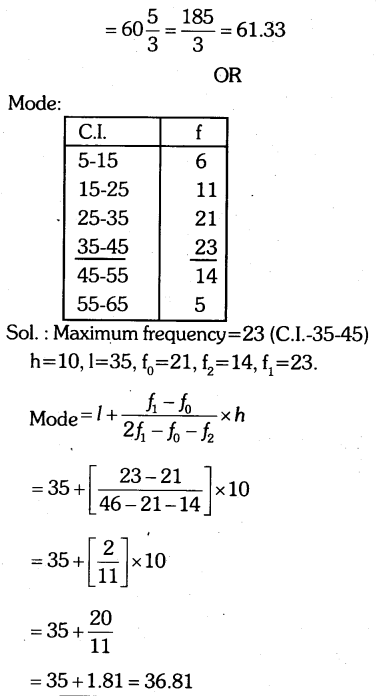
Solution 36.
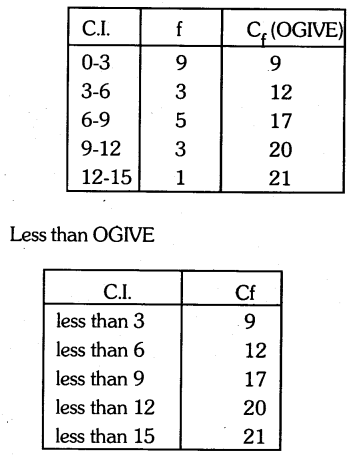
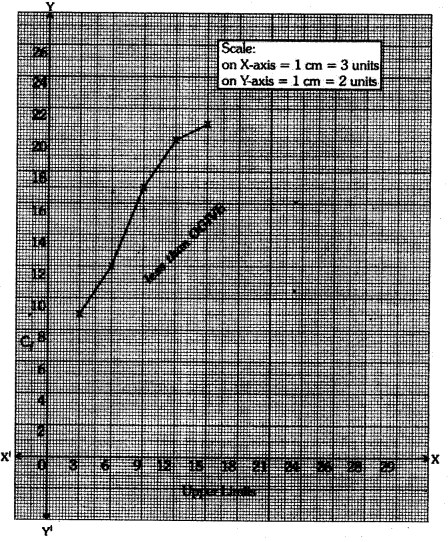
Solution 37.
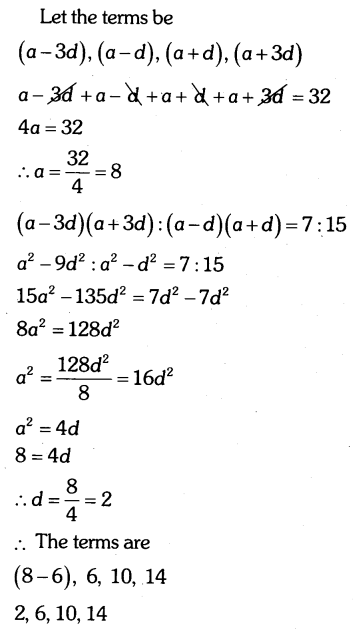
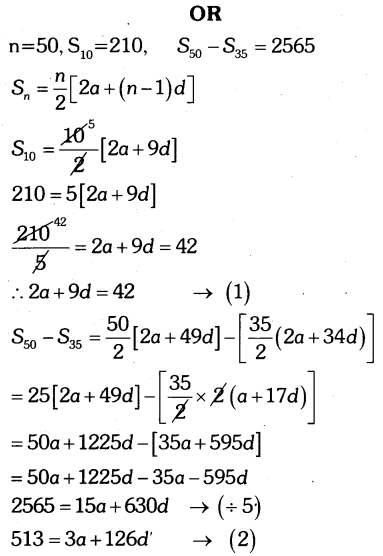
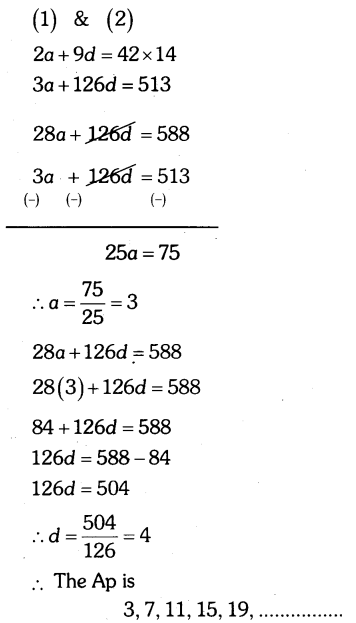
Solution 38.
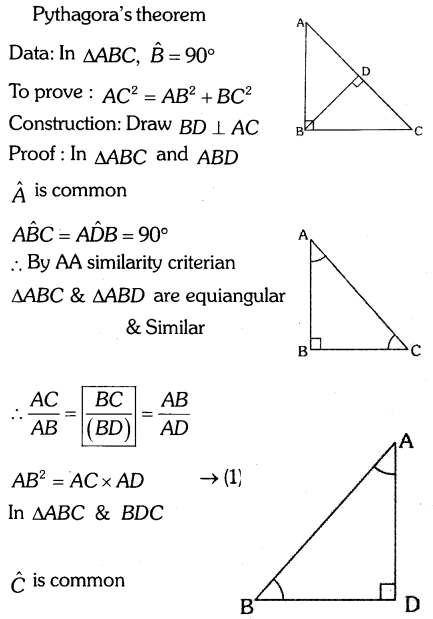
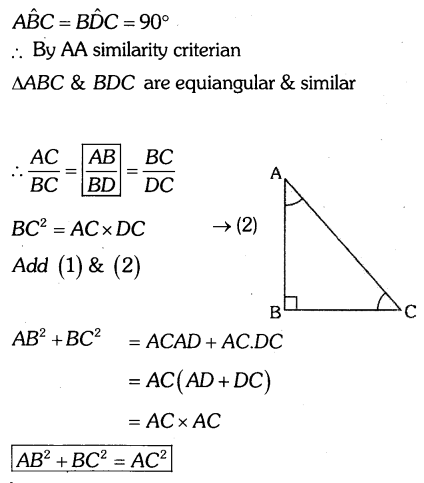
![]()
Solution 39.
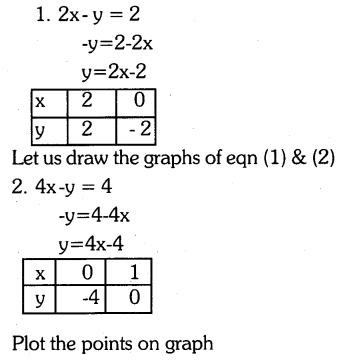
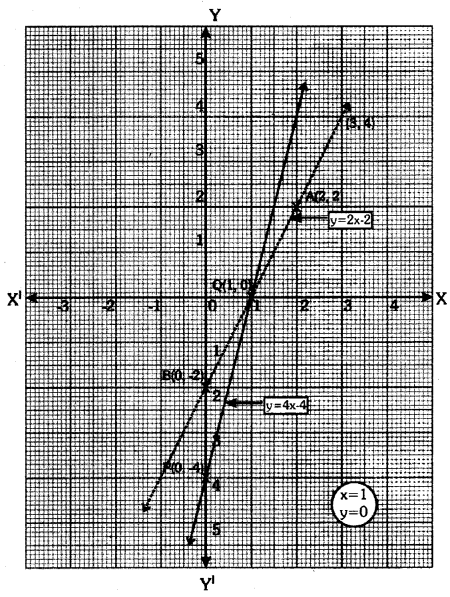
Solution 40.
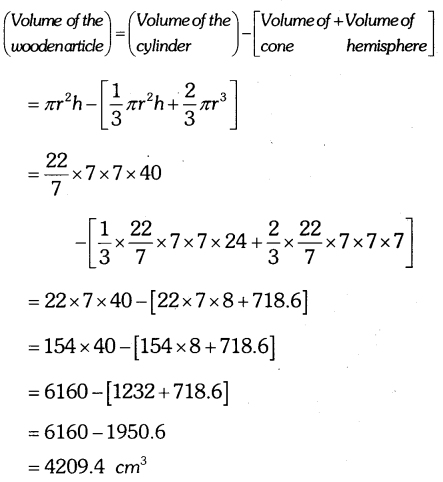
Karnataka State Syllabus SSLC Maths Model Question Paper 2 (Old Pattern)
Four alternatives are given to each question. Choose an appropriate answer. Write it along with its alphabet.
(8 × 1 = 8)
Question 1.
The co-ordinates of the origin are
(a) (0, 0)
b) (1, 0)
(c) (0, 1)
(d) (1, 1)
Question 2.
If p(x) = x3 – 1 then p(-1) = ……..
(a) 2
(b) -2
(c) 1
(d) 0
Question 3.
The total number of all possible events when a dice is thrown once is.
(a) 4
(b) 5
(c) 6
(d) 8
Question 4.
The area of a square is given by
(a) l × b
(b) l × b × h
(c) πr2
(d) l2
Question 5.
If y = 2x – 1 and x + y = 5, then the value of x is
(a) 2
(b) -2
(c) 1
(d) -1
Question 6.
In the adjoining fig AB and AC are tangents from A. If ∠BAC = 80° then BQC
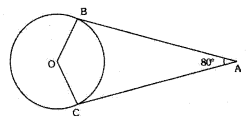
(a) 110°
(b) 100°
(c) 80°
(d) 60°
Question 7.
The graph of an equation cuts x-axis at two points. Then the no. of solutions of that equation is
(a) 0
(b) 1
(c) 2
(d) 3
Question 8.
If the discriminant of a quadratic equation b2 – 4ac > 0 then the roots are
(a) equal
(b) imaginary
(c) unequal & irrational
(d) Real & District
(1 × 6 = 6)
Question 9.
State the converse of “Basic Proportionality theorem”
Question 10.
How are the radius and diameter of a circle related?
Question 11.
Find the HCF of 24 and 36 by factorisation.
Question 12.
If p(x) = x2 – x – 2 find p(o)
Question 13.
Find the distance between the point p (4, 5) and Q (1, 2)
Question 14.
If a no. is divided by 5. which are the remainders?
(2 × 16 = 32)
Question 15.
How many two digits no. are divisible by 4?
Question 16.
∆ABC ~ ∆DEF, Area of ∆DEF = 25 Sqcm. and Area of ∆ABC = 100Sqcm., If DE = 16 cms find AB.
Question 17.
Solve: 3x + 2y = 8, x + 3y = 5
Question 18.
Five years ago A was 7 times as old as B. 20 yrs. later A will be twice as old as B. What are their present ages?
Question 19.
Find the are of the shaded region in the figure given.

![]()
Question 20.
Construct a tangent to a circle of radius 4 cms. at a point on the circumference.
Question 21.
If the coordinates of the vertices of a Δ are (1, 2), (3, 4) and (5, 6). find the perimeter of the triangle.
Question 22.
Prove that 2 + √3 ls irrational.
Question 23.
Find the zeros of the polynomial p(x) = 2x2 – 3x – 5.
Question 24.
Find the quadratic polynomial whose sum & product of zeros are \(\frac { 1 }{ 3 }\) and 2 respectively.
Question 25.
Solve by using formula 5x2 – 9x + 3 = 0
Question 26.
Evaluate : tan2 45° + 2 cos 30° – sin 60°
Question 27.
A tower stands vertically on the ground. From a point on the ground. 15 mts. away from the foot of the tower, the angle of elevation of the top of the tower is 60°. Find the height of the tower.
Question 28.
An observer 1.5 mts tall is 28.5 mts. away from a chimney. The angle of elevation by the top of the chimney from her eyes is 45°, What is the height of the chimney?
Question 29.
A dice is thrown once. Find the probability of getting a number lying between 3 & 6.
(6 × 3 = 18)
Question 30.
The T.S.A. of a cube is 96 Sqcms. Find the volume of the cube.
Question 31.
Prove that the tangents drawn to a circle from an external point are equal.
OR
Prove that tangents drawn to a circle from an external point subtend equal angles at the centre.
Question 32.
Construct a Δ of sides 6 cms, 9 cms and 12 cm and then another Δ similar to it, whose sides are \(\frac { 2 }{ 3 }\) of the corresponding sides of the first triangle.
Question 33.
Solve the following: 8x + 5y = 9, 3x + 2y = 4
OR
A fraction becames \(\frac { 1 }{ 3 }\) when 1 is subtracted from the numerator & it becomes \(\frac { 1 }{ 4 }\) when 8 is added to its denominator. Find the fraction.
Question 34.
If 4 tanθ = 3, Evaluate \(\left[ \frac { 5sin\theta -cos\theta +2 }{ 5cos\theta +sin\theta -2 } \right]\)
Question 35.
Calculate the median for the following data.
| C.I. | f |
| 20-40 | 4 |
| 40-60 | 5 |
| 60-80 | 6 |
| 80-100 | 7 |
| 100-120 | 8 |
| N=30 |
OR
Calculate the mode for the following frequency distribution.
| C.I. | f |
| 15-25 | 1 |
| 25-35 | 6 |
| 35-45 | 15 |
| 45-55 | 18 |
| 55-65 | 9 |
| N=50 |
Question 36.
Constant OGIVE for the following distribution
| C.I. | f |
| 3-6 | 3 |
| 6-9 | 6 |
| 9-12 | 4 |
| 12-15 | 2 |
| 15-18 | 5 |
| N=20 |
(4 × 4 = 16)
Question 37.
How many two digit numbers are divisible by 3?
OR
Find the 31st term of an AR whose 11th term is 38 and the 16th term is 73.
Question 38.
The ratio of the areas of two similar triangles is equal to the square of the ratio of their corresponding sides Prove this.
![]()
Question 39.
Solve graphically : 3x – y = 5, 2x + y = 5
Question 40.
A metallic sphere of radius 4.2 cms is melted and recast into the shape of a cylinder of radius 6 cm. Find the height of the cylinder.
Solutions
Solution 1.
(a) (0, 0)
Solution 2.
(b) -2
Solution 3.
(c) 6
Solution 4.
(d) l2
Solution 5.
(a) 2
Solution 6.
(b) 100°
Solution 7.
(c) 2
Solution 8.
(d) Real & distinct.
Solution 9.
It states that “If a line divides the two sides of a triangle in proportion then that line is parallel to the third side
Solution 10.
diameter = 2 × radius
Solution 11.
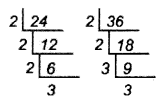
24 = 2 × 2 × 2 × 3
36 = 2 × 2 × 3 × 3
HCF = 2 × 2 × 3 = 12
Solution 12.
p(x) = x2 – x – 2
⇒ p(0) = 02 – 0 – 2
⇒ p(0) = -2
Solution 13.
Distance
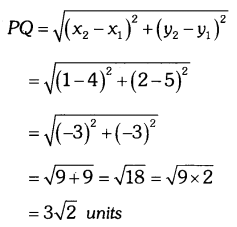
Solution 14.
The Remainders are {0, 1, 2, 3, 4}
Solution 15.
The nos. are 12,16, 20, 24, 28, ……. ,96
a = 12, d = 4, Tn = 96, n = ?
Tn = a + (n – 1) d
⇒ 96 = 12 + (n – 1) 4
⇒ 96 – 12 = 4n – 4
⇒ 84 + 4 = 4n
⇒ 4n = 88
⇒ n = 22
There are 22 two digit nos. divisible by 4.
Solution 16.

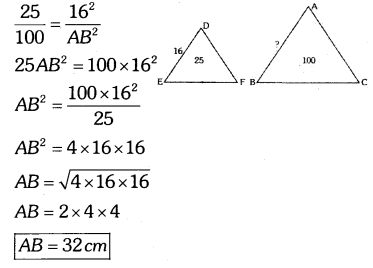
Solution 17.

Solution 18.
Let the present ages of A = x years, B = y years.
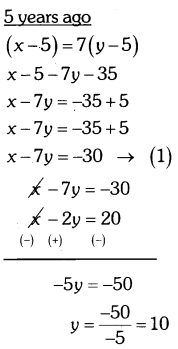
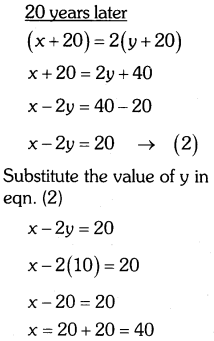
Age of A = 40 years
Age of B = 10 years
Solution 19.
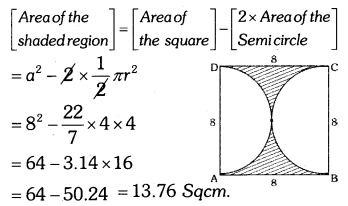
Solution 20.

Solution 21.

Solution 22.
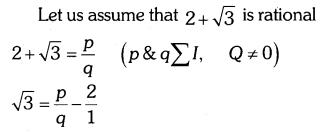
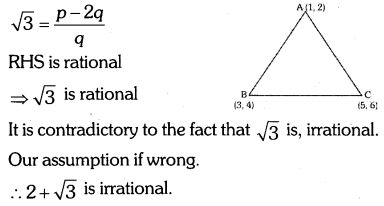
Solution 23.
2x2 – 3x – 5 = 0
2x2 – 5x + 2x – 5 = 0
x[2x – 5] + 1[2x – 5] = 0
(2x – 5)(x + 1) = 0
if 2x – 5 = 0 or if x + 1 = o
2x = 5 or x = 1
x = \(\frac { 5 }{ 2 }\)
The zeroes are 1 and \(\frac { 5 }{ 2 }\)
Solution 24.
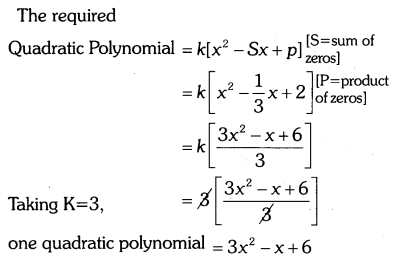
![]()
Solution 25.
It is in the form ax2 + bx + c = 0
a = 5, b = -a, c = 3
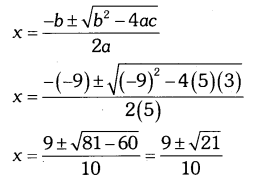
Solution 26.
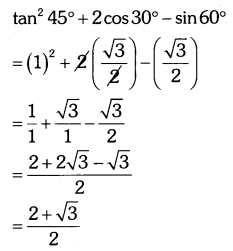
Solution 27.
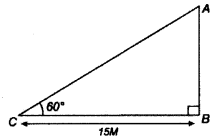
AB = Tower
CB = distance of the point C from the foot of the tower.
ACB is a Right Angle Triangle
tan60° = \(\frac { AB }{ CB }\)
√3 = \(\frac { AB }{ 15 }\)
AB = 15√3 mtrs
Height of the tower = 15√3 Mtrs
Solution 28.
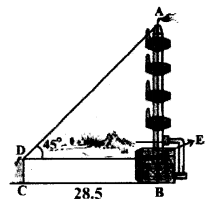
AB = Chimney
CD = Observer
ADE = angle of elevation
ADE is the Right angled ∆
AB = AE + EB = AE + 1.5
DE = CB = 28.5
tan45° = \(\frac { AE }{ DE }\)
1 = \(\frac { AE }{ 28.5 }\)
AE = 28.5
Height of the Chimney = AB = AE + EB = 28.5 + 1.5 = 30 mts.
Solution 29.
No. of all Possible outcomes n(s) = 6 {1, 2, 3, 4, 5, 6}
Let E be the vent of getting a no. between 3 and 6.
n(E) = {4, 5} = 2
p(E) = \(\frac { n(E) }{ n(S) }\) = \(\frac { 2 }{ 6 }\)
Solution 30.
T.S.A. of a cube = 6l2
96 = 6l2
⇒ l2 = 16
⇒ l = √16 = 4
Volume of the cube = l3 = 43 = 64 cc.
Solution 31.
Data: O is the centre of the circle. AB and AC are tangents from A
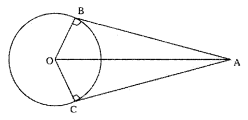
To prove :
AB = AC
Construction:
Join AO, OB and OC.
Proof:
In Δles AOB and AOC
OA is common
OBA = OCA = 90° (angle between radius and tangent)
OB = OC (radii)
By RHS Postulate
ΔAOB = ΔAOC
AB = AC
OR
Data: O is the centre of the circle AB and AC are tangents from A. Join OA, OB & OC.

To Prove : BQA = QOA
Proof:
In Δles AOB and AOC
OA is common
∠OBA = ∠OCA = 90° (angle between radius & tangent)
OB = OC (radii)
By RHS postulate
ΔAOB = ΔAOC
BOA = COA
Solution 32.
AXY is the required Δ
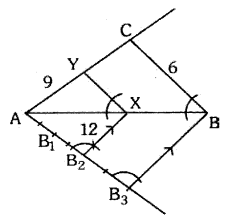
Solution 33.
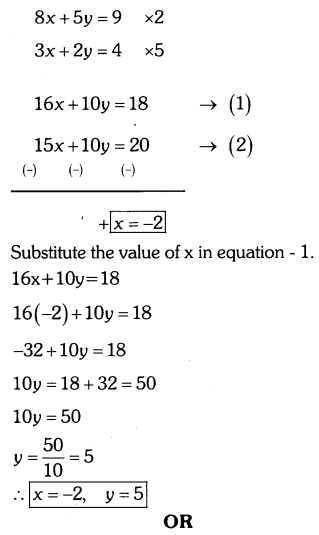
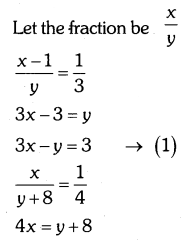
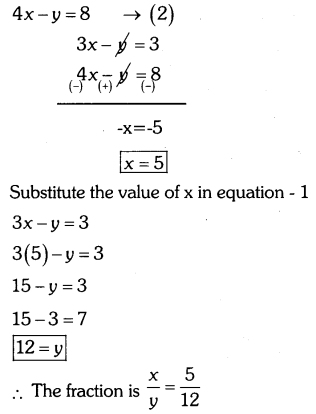
Solution 34.

Solution 35.
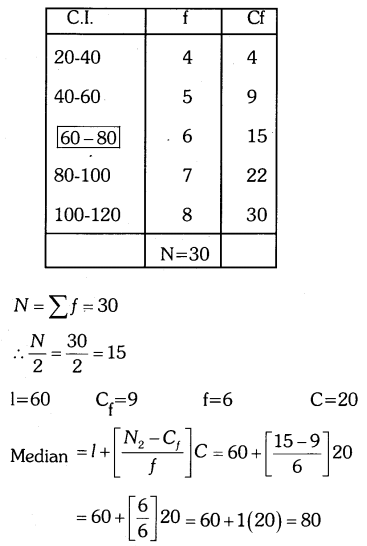
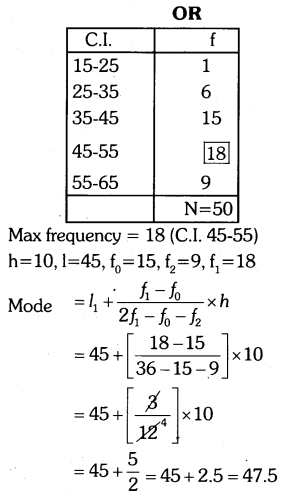
Solution 36.
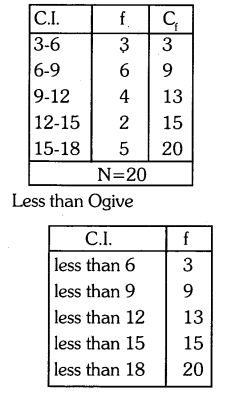
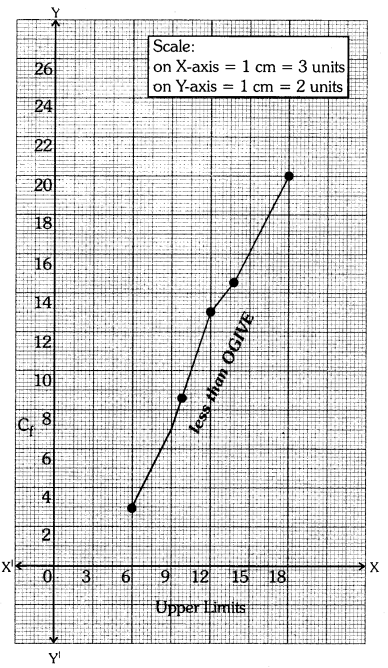
Solution 37.
List of two-digit nos.
divisible by 3 = 12, 15, 18, ……. , 99.
This is an AP
a = 12, d = 3, Tn = 99, n = ?
Tn = a + (n – 1 ) d
⇒ 99 = 12 + (n – 1)3
⇒ 99 – 12 = 3n – 3
⇒ 87 + 3 = 3n
⇒ 90 = 3n
⇒ n = 30
30 two digit nos. are divisible by 3.
OR
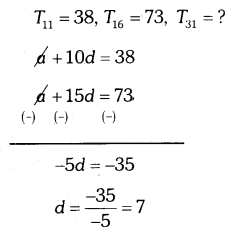
Substitute the value of d in equation 1
a + 10d = 38
⇒ a + 10(7) = 38
⇒ a + 70 = 38
⇒ a = 38 – 70
⇒ a = -32
⇒ T31 = a + 30d
⇒ T31 = -32 + 30(7)
⇒ T31 = -32 + 210
⇒ T31 = 178
![]()
Solution 38.
data: ΔABC || ΔPQR
To Prove that:
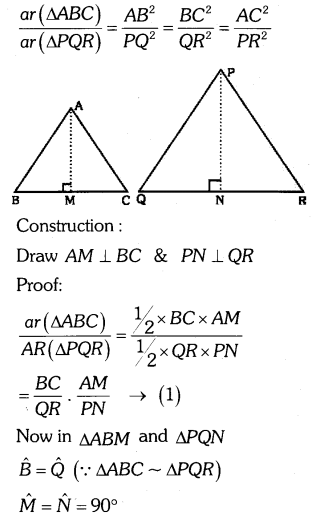
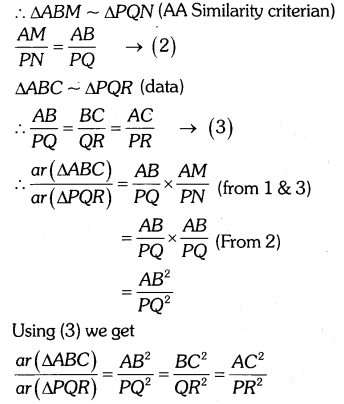
Solution 39.
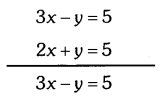
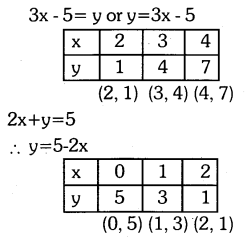
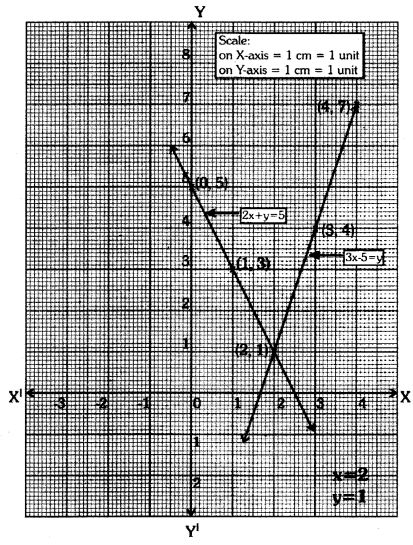
Q = (2, 1) intersecting of two lines.
The two lines intersecting at the point (2, 1), so x = 2, y = 1 is the required solution of the pair of linear equations.
Solution 40.

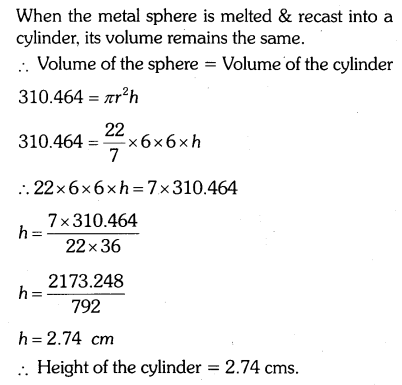
Karnataka State Syllabus SSLC Maths Model Question Paper 3 (Old Pattern)
Four alternatives are given to each question. Choose an appropriate answer. Write it along with its alphabet.
(8 x 1 = 8)
Question 1.
The coordinates of the mid-point P of the join of the points A(x1, y1) and B(x2, y2) is

Question 2.
The quadratic polynomial among the following is
(a) p(x) = x2 + 4x + 3
(b) q(x) = ax + b
(c) g(x) = 4x – 3
(d) f(x) = x3 + 4x2 – 5x + 2
Question 3.
When a dice is thrown twice n(s) = ………
(a) 6
(b) 12
(c) 24
(d) 36
Question 4.
The volume of a sphere is given by
(a) \(\frac { 2 }{ 3 }\) πr3
(b) \(\frac { 4 }{ 3 }\) πr3
(c) 4πr3
(d) 2πr3
Question 5.
The values of x and y which satisfy the given equations are 2x – 3y = 2, 3x – 2y = 8
(a) x = 2, y = 2
(b) x = 3, y = 1
(c) y = 2 , y = 2
(d) x = 2, y = 4
Question 6.
In the given fig AB and AC are tangents from A and BAC = 80° value of BOA = …….
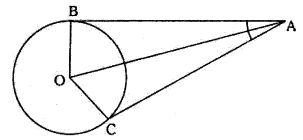
(a) 50°
(b) 60°
(c) 70°
(d) 90°
Question 7.
If A(3, 4) and B(5, 6) are two points, then the coordinates of the mid-point of AB are
(a) (4, 5)
(b) (3, 4)
(c) (5, 6)
(d) (6, 7)
Question 8.
The discriminant of the equation ax2 + bx + c = 0
(a) c2 – 4ab
(b) a2 – 4ab
(c) b2 – 4ac
(d) a2 – 2ac
![]()
(1 × 6 = 6)
Question 9.
State Pythagoras Theorem
Question 10.
What is the length of the longest chord in a circle of radius 5 cms?
Question 11.
Find the HCF of 135 and 225.
Question 12.
From the graph, find the number of zeroes of the polynomial p(x).

Question 13.
Find the distance between A and B if the coordinates of A and B are (2, 3) and (5, 6) respectively.
Question 14.
Express 226 as a product of Prime facotrs.
(2 x 16 = 32)
Question 15.
How many two digit nos. are divisible by 5?
Question 16.
If a pair of corresponding sides of two triangles are 5 cms and 7 cms then find the ratio of the areas of triangles
Question 17.
Solve:
5x + 4y = 14 → (1)
4x + 2y = 10 → (2)
Question 18.
5 Years ago A was thrice as old as his son 20 years, later A will be twice as old as his son. Find their present ages.
Question 19.
Find the area of the sector OAPB
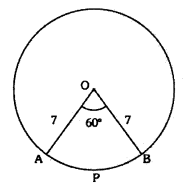
Question 20.
Draw a circle of radius 4 cms. construct a tangent to the circle from a point 10 cms away from the centre.
Question 21.
Find the value of K. If the points A (4, 6), B(8, 2k) and C(12, -6) are collinear.
Question 22.
Prove that 5 + √7 is irrational
Question 23.
Find the zeros of the polynomial p(x) = 6x2 + 7x – 3
Question 24.
Find the quadratic polynomial, whose sum & Product of the zeros are \(\frac { 1 }{ 2 }\) & 2 respectively.
Question 25.
Solve by using formula 2x2 – 5x + 3 = 0
Question 26.
Evaluate : 2 sin2 60° + 3 tan2 45° – cos2 30°
Question 27.
The angle of elevation of the top of a tower from a point on the ground, which is 60 M away from the foot of the tower is 30°. Find the height of the tower.
Question 28.
As observed from the top of a 200M height tower from the sea level the angle of depression of two boats are 30° and 45°, if one of the boats is exactly behind the other on the same side of the tower, find the distance between two boats (√3 = 1.73).
Question 29.
A dice is thrown once. Find the probability of getting a perfect square number.
Question 30.
A copper rod of diameter 1 cm and length 8 cms. is drawn into a wire of length 18 m of uniform thickness. Find the thickness of the wire.
(16 x 2 = 32)
Question 31.
Prove that in two concentric circles the chord of the larger circle, which touches the smaller circle is bisected at the point of contact.
OR
Prove that the tangent at any point of a circle is perpendicular to the radius through the point of contact.
Question 32.
Construct a triangle of side 6 cm., 9 cm and 1 cm. and then a triangle similar to it whose side, are \(\frac { 2 }{ 3 }\) of the corresponding sides of the first triangle.
Question 33.
Solve the following equations by reducing them to a pair of linear equation.

OR
5 pencils and 7 books together cost Rs. 50. whereas 7 pencils & 5 books together cost Rs. 46. Find the cost of 1 pencil and 1 book.
Question 34.
If sin 3A = cos (A – 26°). Where 3A is an acute angle, find the value of A.
OR

Question 35.
Calculate the median for the following data.
| C.I. | f |
| 0 – 20 | 4 |
| 20 – 40 | 6 |
| 40 – 60 | 8 |
| 60 – 80 | 10 |
| 80 – 100 | 4 |
| 100 – 120 | 5 |
| 120 – 140 | 3 |
| n = 40 |
OR
Calculate the mode for the following frequency distribution
| C.I. | f |
| 5 – 15 | 3 |
| 15 – 25 | 8 |
| 25 – 35 | 17 |
| 35 – 45 | 20 |
| 45 – 55 | 11 |
| 55 – 65 | 1 |
| n = 60 |
Question 36.
Construct ‘OGIVE’ for the following:
| C.I. | f |
| 0 – 3 | 8 |
| 3 – 6 | 2 |
| 6 – 9 | 4 |
| 9 – 12 | 2 |
| 12 – 15 | 1 |
| n = 17 |
(4 x 4 = 16)
Question 37.
Find the 11th term from the last term (towards the first-term) of the AR 10, 7, 4,…….., -62.
OR
In a flower bed there are 23 rose plants in the first row, 21 in the second, 19 in the third & so on. There are 5 rose-plants in the last row. How many rows are there in the flower bed ?
Question 38.
In a triangle if square as one side is equal to the sum of the squares on the other two sides, then the angle opposite to the first side is a right angle, prove this.
Question 39.
Solve Graphically :
2x – y = 5
4x – y = 13
Question 40.
Ram made a bird bath for his garden in the shape of a cylinder with a hemispherical depression at one end. The height of the cylinder is 1.45 m and its radius is 30 cms. Find the T.S.A. of the bird bath.
Solutions
Solution 1.
(b)

Solution 2.
(a) p(x) = x2 + 4x + 3
Solution 3.
(d) 36
Solution 4.
(b) \(\frac { 4 }{ 3 }\) πr3
Solution 5.
(c) x = 4, y = 2
Solution 6.
(a) 50°
Solution 7.
(a) (4, 5)
Solution 8.
(c) b2 – 4ac
Solution 9.
“In a right-angled triangle the square on the hypotenuse is equal to the sum of the squares as the other two sides”.
Solution 10.
10 cm.
Solution 11.
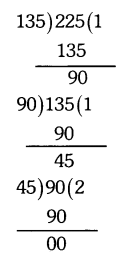
By division lemma
225 = 135 x 1 + 90
135 = 90 x 1 + 45
90 = 45 x 2 + 0
The last divisor is 45
HCF = 45
Solution 12.
4
Solution 13.
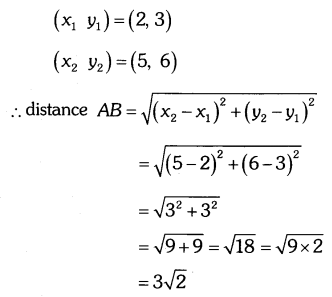
Solution 14.

Solution 15.
Nos. divisible by 5 are 10, 15, 20, ………, 95
They are in AP
a = 10, d = 5, Tn = 95, n = ?
Tn = a + (n – 1)d
⇒ 95 = 10 + (n – 1)5
⇒ 95 – 10 = 5n – 5
⇒ 85 + 5 = 5n
⇒ 90 = 5n
⇒ n = 18
18 two digit nos. are divisible by 5.
Solution 16.
Let ABC and PQR be the triangles.

Solution 17.

Substitute the value of x in eqn. 1.
5x + 4y = 14
⇒ 5(2) + 4y = 14
⇒ 10 + 4y = 14
⇒ 4y = 14 – 10
⇒ 4y = 4
⇒ y = 1
∴ x = 2, y = 1
Solution 18.
Let the age of A = x years
Let the age of son = y years
5 years ago
(x – 5) = 3(y – 5)
x – 5 = 3y – 15
x – 3y = -15 + 5
x – 3y = -10 …..(1)
20 years later
(x + 20) = 2(y + 20)
x + 20 = 2y + 40
x – 2y = 40 – 20
x – 2y = 20 …… (2)
From Eqn (1) & (2)
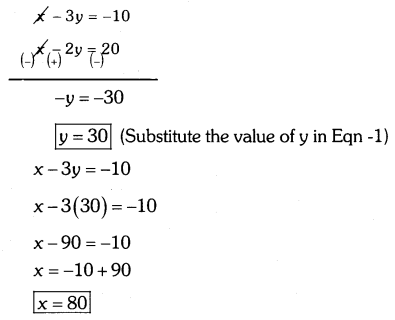
Present age of the father = 80 years
Age of the son = 30 years.
Solution 19.

Solution 20.
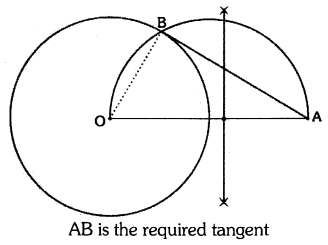
Solution 21.
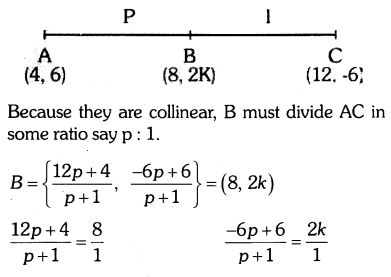
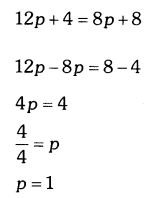
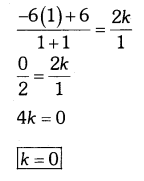
Solution 22.
Let us assume that 5 + √7 is rational.
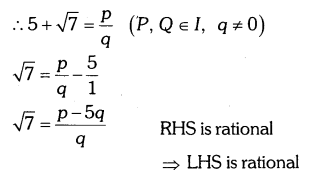
but √7 is irrational.
If contradicts the fact that √7 is irrational
our assumption is wrong.
(5 + √7) is irrational.
Solution 23.
p(x) = 6x2 + 7x – 3
By splitting the middle term
6x2 + 9x – 2x – 3
⇒ 3x(2x + 3) – 1(2x + 3)
⇒ (2x + 3) (3x – 1)
for zeroes of p(x) put
2x + 3 = 0 and 3x – 1 = 0
x = \(\frac { -3 }{ 2 }\) and x = \(\frac { 1 }{ 3 }\)
zeroes of p(x) are \(\frac { -3 }{ 2 }\) and x = \(\frac { 1 }{ 3 }\)
Solution 24.

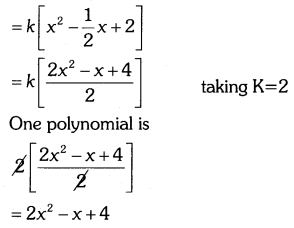
Solution 25.
Compare this with ax2 + bx + c = 0
a = 2, b = -5, c = 3
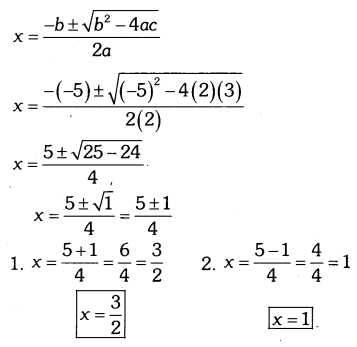
Solution 26.
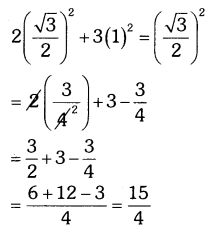
![]()
Solution 27.
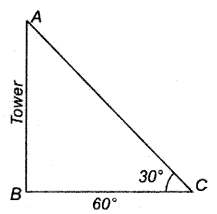
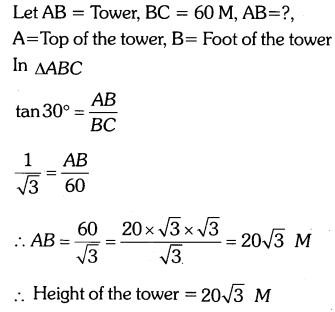
Solution 28.
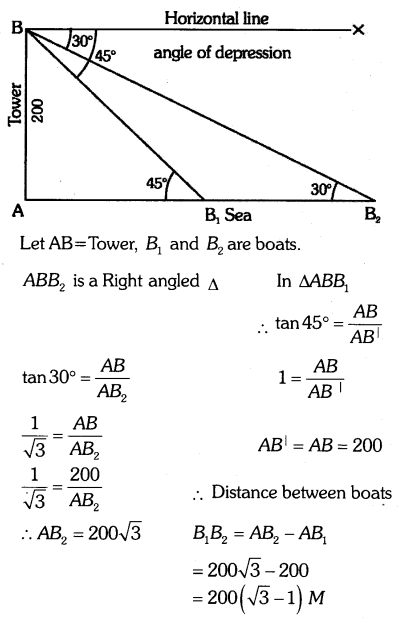
Solution 29.
No. of all possible outcomes n(S) = 6
Let ‘E’ be the event of getting a perfect square no.
n(E) = 2 {1, 4}
p(E) = \(\frac { n(E) }{ n(S) }\) = \(\frac { 2 }{ 6 }\)
Solution 30.
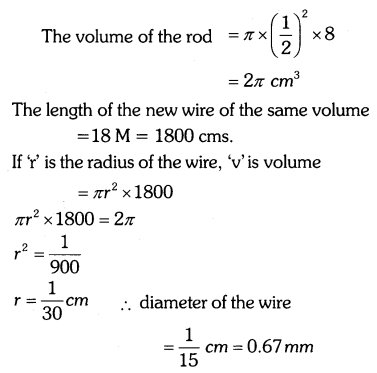
Solution 31.
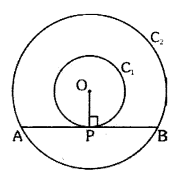
Data: Two concentric circles C1 and C2 have the same centre O.
AB is the chord of the larger circle C2.
It touches C1 at P
To prove AP = PB
Construction: Join OP
Proof: AB is the tangent to C1 at P and OP is the radius.
OP ⊥ AB
AB is the chord for C2 & OP ⊥ AB
OP is the bisector of AB, as the perpendicular from the centre bisects the chord.
i.e., AP = BR
OR
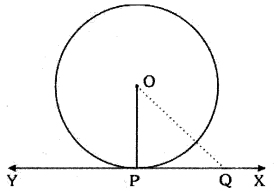
Data: ‘O’ is the centre of the circle XY is a tangent at P.
To prove: QP ⊥ XY
Construction: Take a point Q as XY other than P and join OQ.
Proof: The point P lies outside the circle (if it lies inside XY becomes a secant).
OQ is longer than OP (radius)
OQ > OP
Since this happens for every point on XY except the point P
OP is the shortest of all the distances from the point O to the points on XY.
So, OP is the perpendicular to XY.
Solution 32.
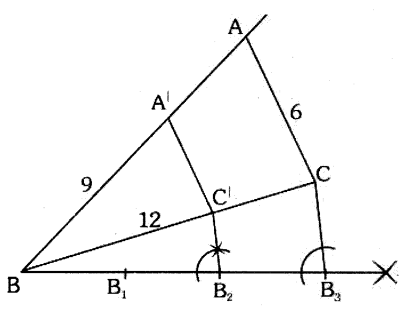
ΔABC is required Δ
ΔA’BC’ is required Δ
Solution 33.
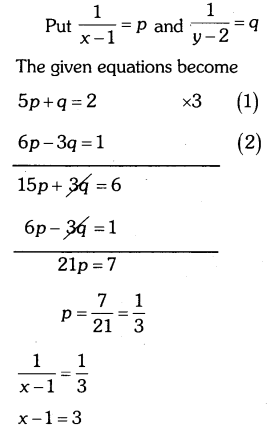
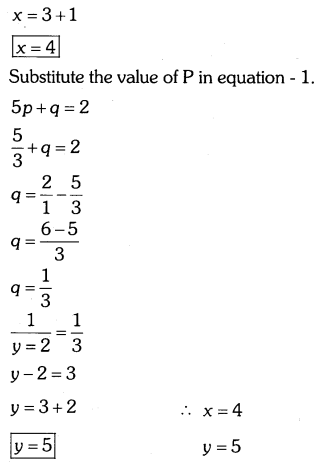
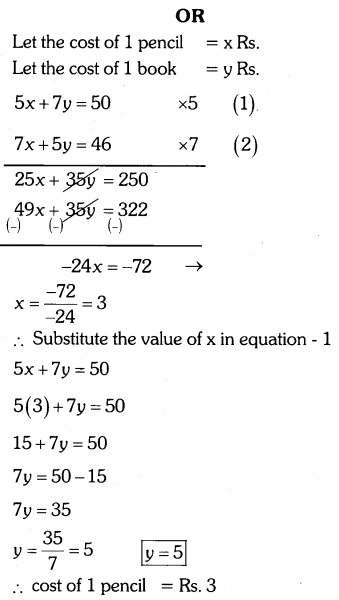
Solution 34.
sin3A = cos(A – 26°)
⇒ sin 3A = cos (90 – 3A)
⇒ cos (90 – 3A) = cos (A – 26)
⇒ 90 – 3A = A – 26
⇒ 90 + 26 = A + 3A
⇒ 116 = 4A
⇒ A = 29°
OR
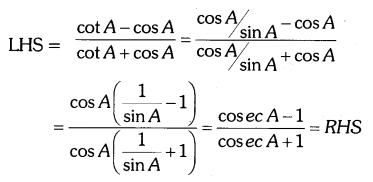
![]()
Solution 35.
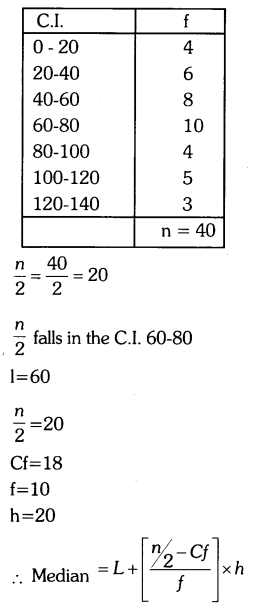
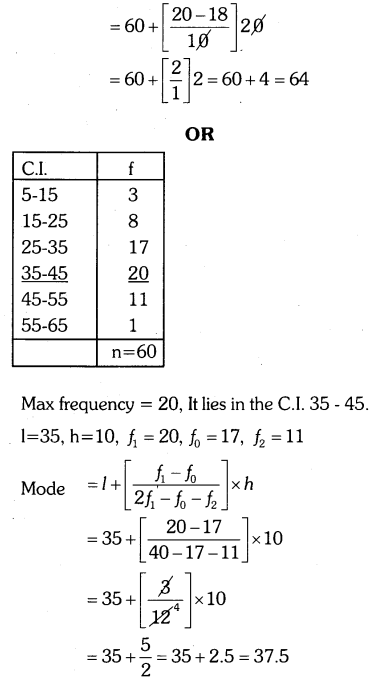
Solution 36.

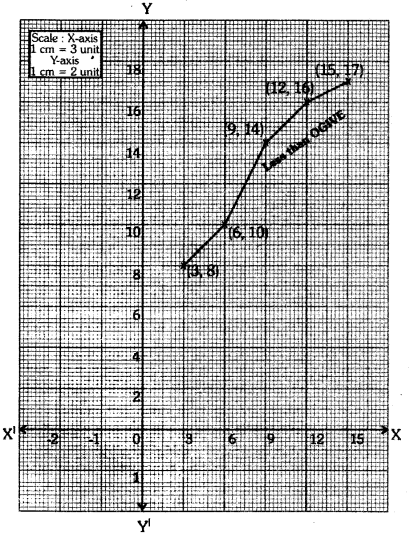
Solution 37.
If we write the given AP in the reverse order, then a = -62 and d = 3.
Now find the 11th term with these a and d.
so, a11 = -62 + (11 – 1) x 3
a11 = -62 + 30
an = -32
OR
The number of rose plants in 1st, 2nd, 3rd, ……… rows are
23, 21, 19, ………. 5
It forma an AP
Let the number of rows = n
a = 23, d = -2, an = 5
an = a + (n – 1)d
⇒ 5 = 23 + (n – 1)(-2)
⇒ 5 – 23 = -2n + 2
⇒ -18 – 2 = -2n
⇒ -20 = -2n
⇒ n = 10
No. of rows = 10
Solution 38.
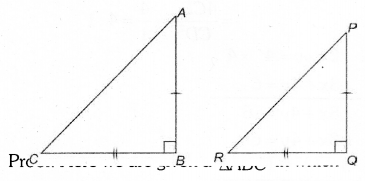
AC2 = AB2 + BC2
we need to prove ∠B = 90°
construct ΔPQR , right angled at Q such that
PQ = AB & QR = BC
Now from ΔPQR , we have
PR2 = PQ2 + QR2 (by pythogora’s theorem)
PR2 = AB2 + BC2 (by construction)
AC2 = AB2 + BC2 (data)
AC = PR
In ΔABC and ΔPQR
AB = PQ (by construction)
BC = QR (by construction)
AC = PR (Proved)
ΔABC = ΔPQR
∠B = ∠Q (CPCT)
∠Q = 90° (by Construction)
∠B = 90°
Solution 39.

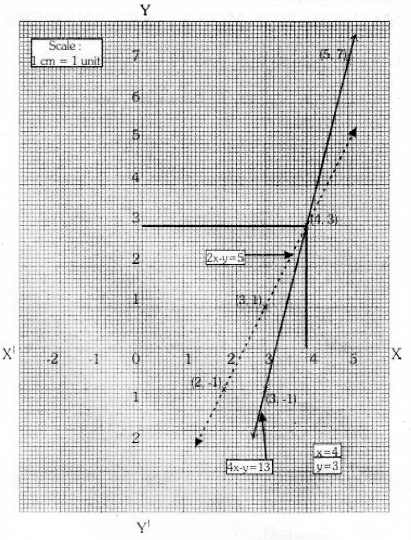
Solution 40.
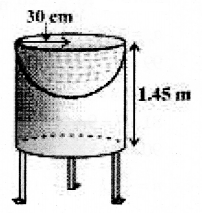
Let h be the height of the cylinder and r the common radius of cylinder
hemi-sphere T.S.A. of bird-bath = CSA of cylinder + CSA of the hemisphere.
= 2πrh + 2πr2
= 2πr (h + r)
= 2 x \(\frac { 22 }{ 7}\) x 30 (145 + 30)
= 2 x \(\frac { 22 }{ 7}\) x 30 x 175
= 33000 cm2
![]()
Karnataka State Syllabus SSLC Maths Model Question Paper 4 (Old Pattern)
Four alternatives are given to each question. Choose an appropriate answer. Write it along with its alphabet.
(1 × 8 = 8)
Question 1.
The distance between two points A (1, 7) and B (4, 2) is
(a) √34
(b) √43
(c) √68
(d) √86
Question 2.
If p(x) = x2 + x + 1 then the value of p(-1) is
(a) -1
(b) 1
(c) 2
(d) -2
Question 3.
Which is correct for the event E?
(a) P(\(\bar { E }\)) = 1 + P(E)
(b) P(\(\bar { E }\)) = P(E)
(c) P(\(\bar { E }\)) = 1 – P(E)
(d) P(E) = 1 + P(\(\bar { E }\))
Question 4.
The volume of a cylinder is 154 cc. and the radius is 7 cms. then the height is
(a) 2 cms
(b) 3 cms
(c) 4 cms
(d) 1 cm
Question 5.
The value of x and y for the following equations are x + y = 15, x – 7 = 1
(a) (8, 7)
(b) (7, 8)
(c) (10, 5)
(d) (5, 10)
Question 6.
ABCD is a cyclic quadrilateral. A = 70°, then C = ?
(a) 100°
(b) 110°
(c) 120°
(d) 70°
Question 7.
OA is a radius in the circle. If coordinates of A are (2, 3) then OA =…
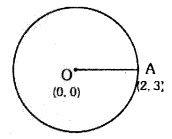
a) √9
b) √4
c) √13
d) √5
Question 8.
If the discriminant of a quadratic equation b2 – 4ac < 0 then the roots are
(a) Real and distinct
(b) equal
(c) not real
(d) unequal&rational
(1 × 6 = 6)
Question 9.
In ΔABC, XY || BC, If AX = 2 cm, AB = 5 cms and AY = 4 cms. then AC = ………
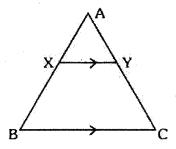
Question 10.
Identify the largest chord in the given figure.
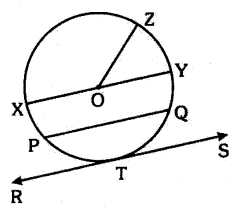
Question 11.
Find the HCF of 25 and 15
Question 12.
From the graph find the number of zeros of the polynomial p(x)
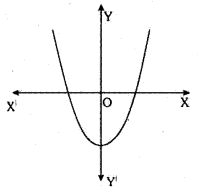
Question 13.
Which are the coordinates of the origin?
Question 14.
Express 200 as a product of prime factors.
(16 × 2 = 32)
Question 15.
How many 2 digit numbers are divisible by 9.
Question 16.
Diagonals of a trapezium ABCD with AB || DC intersect at O. If AB = 2CD. Find the ratio of the areas of triangles AOB and COD.
Question 17.
Solve for x and y
2x + y = 4
3x + 4y = 6
Question 18.
Half the perimeter of a rectangle whose length is 4 m. more than its width is 36 m. Find the dimensions of the garden.
Question 19.
Find the area of the shaded region in the fig given. If each side of the square is 14 cm.
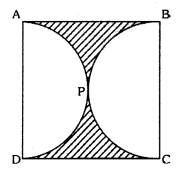
Question 20.
Draw a circle of radius 4 cms. Draw two radii in it such that the angle between them is 130°. Construct two tangents at the ends of radii.
Question 21.
The coordinates of the vertices of a triangle are (2, 3), (4, 5) and (6, 9). Find its area.
Question 22.
Prove that (5 + √3) is irrational.
Question 23.
Find the zeros of the polynomial p(x) = 5x2 – 2x – 3
Question 25.
Solve the given equation using formula x2 – 6x – 4 = 0
Question 26.
If A = √2 – 1 show that \(\frac { tanA }{ 1+{ tan }^{ 2 }A } =\frac { \surd 2 }{ 4 }\)
Question 27.
From a point an the ground, the angles of elevation of the bottom and top of a tower fixed at the top of 20 m high building is 45° & 60° respectively. Find the height of the tower.
Question 28.
The angle of elevation of an aeroplane from a point on the ground is 60°. After 15 seconds flight the elevation changes to 30°. If the aeroplane is flying at a height of 1500√3 m, find the speed of the plane in km/hr.
Question 29.
12 defective pens are mixed with 132 good ones one pen is taken out at random from this lot. Find the probability that the pen is taken out is a good one.
(6 × 3 = 18)
Question 30.
Two cubes each of volume 64 cm3 are joined end to end. Find the surface area of the resulting cuboid.
Question 31.
Prove that in two concentric circles the chord of the longer circle, which touches the smaller circle is bisected at the point of contact.
OR
Prove that the tangents drawn to a circle from an external point are equal.
Question 32.
Construct a Δ of sides, 8 cms., 10 cms & 12 cms. and then A similar to it, whose sides are \(\frac { 3 }{ 4 }\) the corresponding sides of the first Δ
Question 33.
90% and 97% acid solutions are mixed to get 21 Its. of 95% pure acid solution. Find the amount of each type of acid to be mixed to form the mixture.
OR
One says “give me a hundred friend I shall then become twice as rich as you”. The other says “If you give me 10,1 shall be 6 times as rich as you”. Find the amount of their capital.
Question 34.
If A, B, C are interior angles of a triangle ABC show that
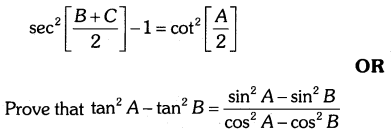
Question 35.
Calculate the median for the following data
| C.I. | f |
| 65 – 85 | 4 |
| 85 – 105 | 5 |
| 105 – 125 | 13 |
| 125 – 145 | 20 |
| 145 – 165 | 14 |
| 165 – 185 | 8 |
| 185 – 205 | 4 |
OR
Calculate the mode for the following data.
| C.I. | f |
| 1000 – 1500 | 24 |
| 1500 – 2000 | 40 |
| 2000 – 2500 | 33 |
| 2500 – 3000 | 28 |
| 3000 – 3500 | 30 |
| 3500 – 4000 | 22 |
| 4000 – 4500 | 16 |
| 4500 – 5000 | 07 |
Question 36.
Draw the ‘less than type OGIVE for the following data.
| C.I. | f |
| 50 – 60 | 6 |
| 60 – 70 | 5 |
| 70 – 80 | 9 |
| 80 – 90 | 12 |
| 90 – 100 | 6 |
(4 × 4 = 16)
Question 37.
Which term of the A.P 45, 41, 37, 33, ………… is the first negative term?
OR

Question 38.
Prove that in a Δ, if square as one side is equal to the sum of the squares of the other two sides, then the angle opposite the first side is a right angle.
Question 39.
Solve Graphically
x + 3y = 6
2x – 3y = 12
Question 40.
The base radius and height of a right circular solid cone are 2 cms and 8 cms respectively. It is melted & recast into spheres of diameter 2 cms. each. Find the number of spheres formed.
Solutions
Solution 1.
(a) √34
Solution 2.
(b) 1
Solution 3.
(c) P(\(\bar { E }\)) = 1 – P(E)
Solution 4.
(d) 1 cm
Solution 5.
(a) (8, 7)
Solution 6.
(b) 110°
Solution 7.
(c) √13
Solution 8.
(c) not real
Solution 9.
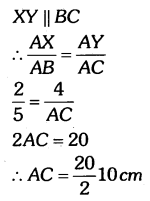
Solution 10.
XY
Solution 11.
25 = 5 × 5
15 = 5 × 3
Solution 12.
2
Solution 13.
(0, 0)
Solution 14.

200 = 2 × 2 × 2 × 5 × 5 = 23 × 52
Solution 15.
Two digit Nos. are 18, 27, 36, ……. 99
It is in AP
a = 18, d = 9, an = 99, n = ?
an = a + (n – 1) d
⇒ 99 = 18 + (n – 1)9
⇒ 99 – 18 = 9n – 9
⇒ 81 + 9 = 9n
⇒ 90 = 9n
⇒ n = 10
There are 10 two digit nos.
Solution 16.
Area of ∆AOB and ∆COD
AÔB = COD (V.O.A.)
COO = OA (alternate angles)
By AA Similarity criterion
∆AOB ~ ∆DOC
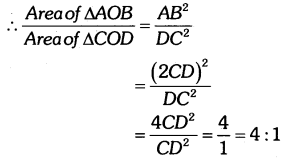
Solution 17.
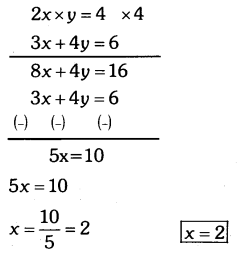
Substitute the value of x in equation 1
2x + y = 4
⇒ 2(2) + y = 4
⇒ 4 + y = 4
⇒ y = 4 – 4 = 0
x = 2, y = 0
Solution 18.
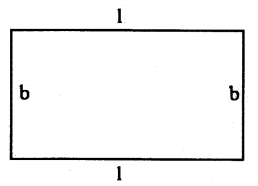
l + b = 36
⇒ l = 36 – b
l = b + 4
b + 4 = 36 – b
⇒ b + b = 36 – 4
⇒ 2b = 32
⇒ b = 16
l = b + 4
⇒ l = 16 + 4
⇒ l = 20
Length = 20 m
Width = 16 m
Solution 19.


Solution 20.
PA and PB are tangents to the circle at the ends of radii
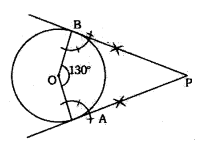
Solution 21.
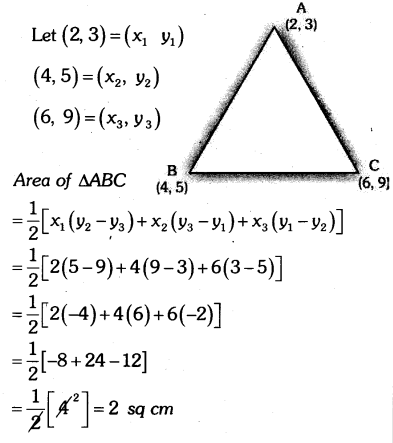
![]()
Solution 22.
Let us assume that (5 + √3)
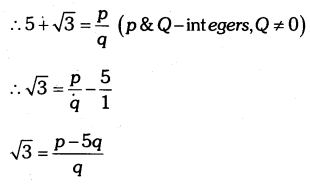
RHS is rational
⇒ √3 is rational
But √3 is irrational
It is contradictory to the fact that √3 is irrational
Hence our assumption is wrong.
(5 + √3) is irrational.
Solution 23.
To get the zeros of the, polynomial
put p(x) = 0
⇒ 5x2 – 2x – 3 = 0
⇒ 5x2 – 5x + 3x – 3 = 0
⇒ 5x(x – 1) + 3(x – 1) = 0
⇒ (x – 1)(5x + 3) = 0
x – 1 = 0 or 5x + 3 = 0
x = 1 or x = \(\frac { -3 }{ 5 }\)
Zeros of the polynomial are 1 and \(\frac { -3 }{ 5 }\)
Solution 24.
Here a = a, b = -5, c = c
Let the zeros be α and β then
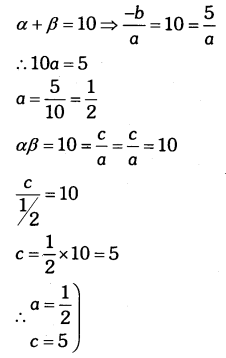
Solution 25.
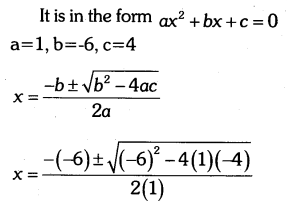
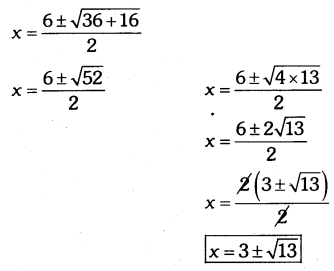
Solution 26.
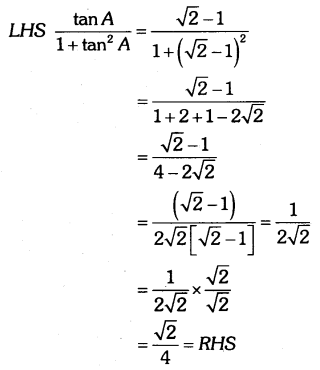
Solution 27.
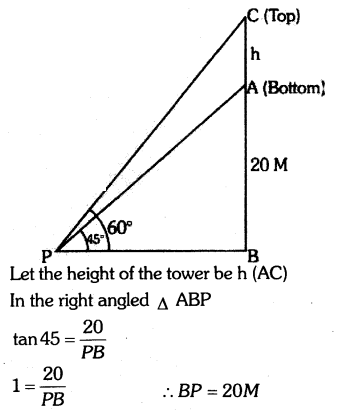
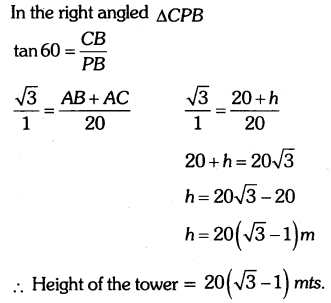
Solution 28.

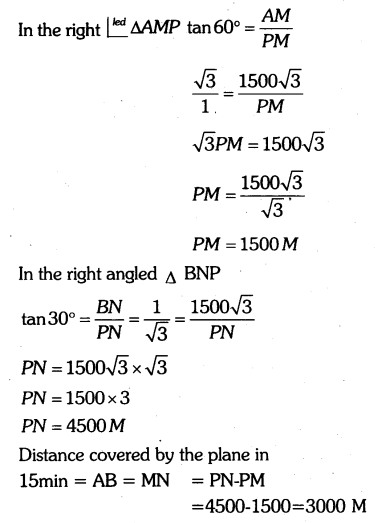
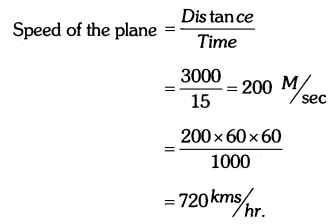
Solution 29.
No. of defective pens = 12
No. of good pens = 132
Total no. of pens = 144
No. of all possible outcomes = 144
Let E be the event that the pen taken out is a good one
No. of outcomes favourable to E = 132

Solution 30.
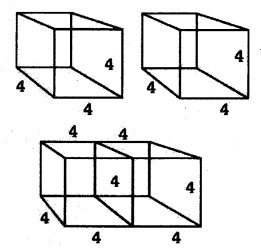
Let each edge of the cube be a
Volume of each cube = a3
64 = a3
⇒ a = 4
For the resulting cuboid l = 4 + 4 = 8 cm
breadth = 4 cm
Height = 4 cm.
Surface area of the resulting cuboid = 2(lb + bh + hl)
= 2[(8 × 4) + (4 × 4) + (4 × 8)]
= 2[32 + 16 + 32]
= 2 [80]
= 160 cm2
Solution 31.
C1 and C2 are the concentric circle with centre O A chord AB of the larger circle C touches the smaller circle C2 at P
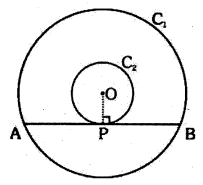
To prove: AP = BP
Construction: Join OP
Proof: AB is a tangent to the circle C2 at P and OP is the radius.
OP ⊥ AB
AB is the chord of circle Q & OP ⊥ AB
OP is the bisector of chord AB
AP = PB
OR
Data: O is the centre of the circle. AB and AC are tangents from A
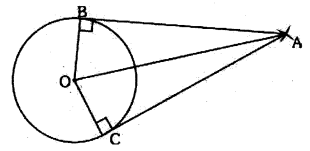
To prove AB = AC
Construction: Join OA, OB and OC
Proof: In ΔAOB and ΔAOC
ABO = ACO = 90° [Angle between radius & tangent]
OB = OC (Radii of the circle)
OA is common
By RHS criterian
ΔAOB = ΔAOC
AB = AC
Solution 32.
A’CC’ is the required triangle
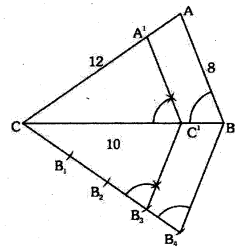
Solution 33.
Let x Lts of 90% pure acid solution & Y Lts of 97% pure acide solution be mixed,
total volume of the mixture = (x + y) Lts
x + y = 21 ……… (1)
90% of x + 97% of y = 95% of 21
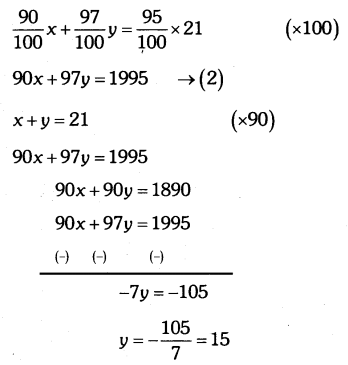
Substituting the value of y in eqn 1
x + y = 21
⇒ x + 15 = 21
⇒ x = 21 – 15 = 6
⇒ x = 6
Quantity of 90% pure acid solution = 6 Lts.
Quantity of 97% pure acid solution = 15 Lts.
OR
Let the amounts with them be respectively.
x and y
x + 100 = 2(y – 100)
⇒ x + 100 = 2y – 200
⇒ x – 2y = -200 – 100
⇒ x – 2y = -300 ……. (1)
y + 10 = 6(x – 10)
⇒ y + 10 = 6x – 60
⇒ y – 6x = -60 – 10
⇒ -6x + y = -70
⇒ 6x – y = 70 ……… (2)
From Equation 1
x = 2y – 300
Substituting the value of x in equation 2
6x – y = 70
⇒ 6(2y – 300) – y = 70
⇒ 12y – 1800 – y = 70
⇒ 11y = 70 + 1800
⇒ 11y = 1870
⇒ y = 170
Substitute the value Y in (1)
x = 2y – 300
⇒ x = 2(170) – 300
⇒ x = 340 – 300
⇒ x = 40
Their capitals are 40 Rs. & 170 Rs.
![]()
Solution 34.
Because A, B, C are the angles of a ∆ABC
A + B + C = 180°
⇒ B + C = (180 – A)
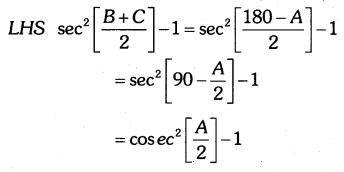
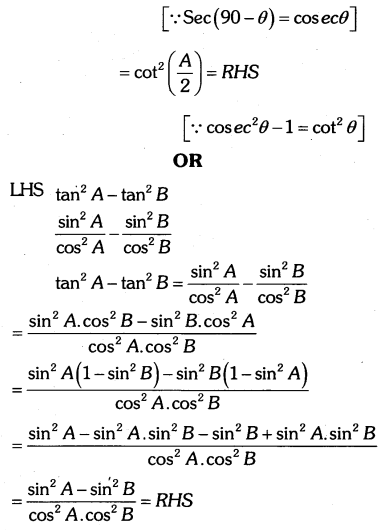
Solution 35.
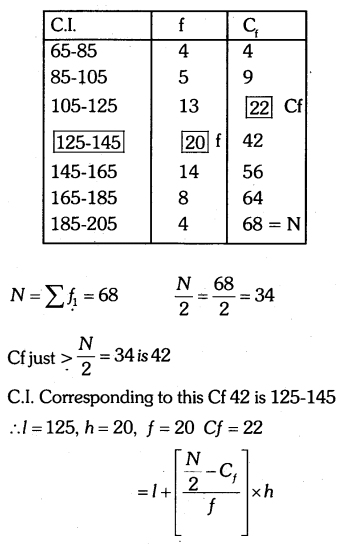
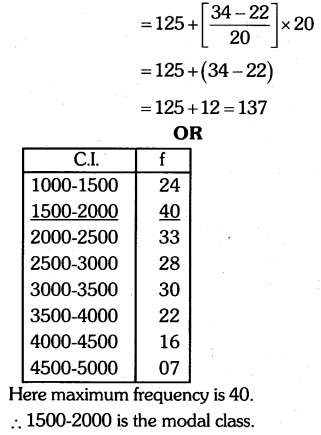
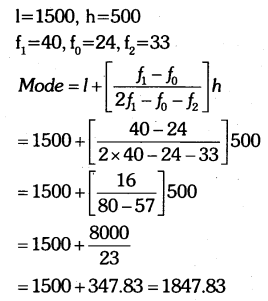
Solution 36.
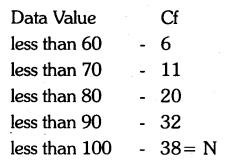
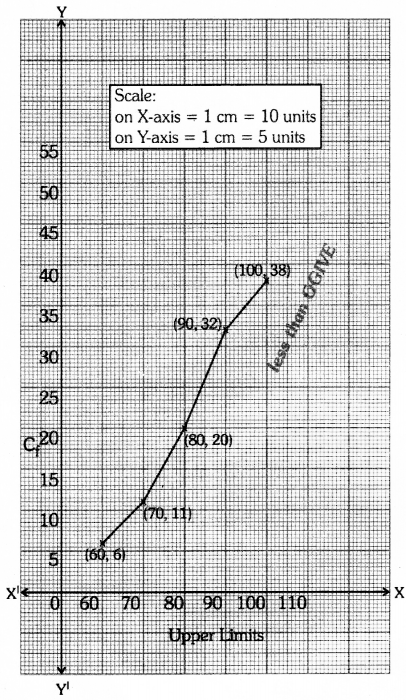
Solution 37.
a = 45
d = a2 – a1 = 41 – 45 = -4
Let nth term of the AP be the first negative term then an < 0
a + (n – 1)d < 0
⇒ 45 + (n – 1) (-2) < 0
⇒ 45 – 4n + 4 < 0
⇒ 49 – 4n < 0
⇒ 49 < 4n
⇒ n > \(\frac { 49 }{ 4 }\)
⇒ n > 12\(\frac { 1 }{ 4 }\)
least positive integral value of n = 13
13th term is the first negative term.
OR
Let ‘a’ be the first term and d the common difference
a4 = a + (4 – 1) d = a + 3d
a6 = a + 5d
a7 = a + 6d
a8 = a + 7d

Solution 38.

data : ABC is a ∆ in which AC2 = AB2 + BC2
To prove: ∠B = 90°
Construction: Construct ∆PQR right angled at Q such that
PQ = AB & RQ = CB
Proof: PR2 = PQ2 + RQ2 (by Pythagoras theorem)
PR2 = AB2 + BC2 (by construction)
But AC2 = AB2 + BC2 (data)
AC = PR
In ∆ABC and ∆PQR
AB = PQ
BC = QR (by construction)
AC = PR (proved)
∆ABC = ∆PQR
∠B = ∠Q
but ∠Q = 90° (by construction)
∠B = 90°
Solution 39.
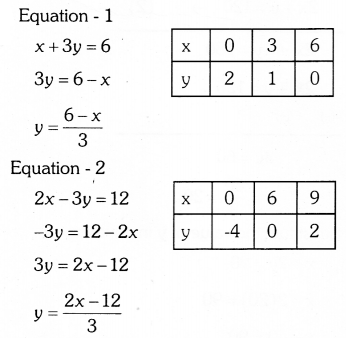

Solution 40.
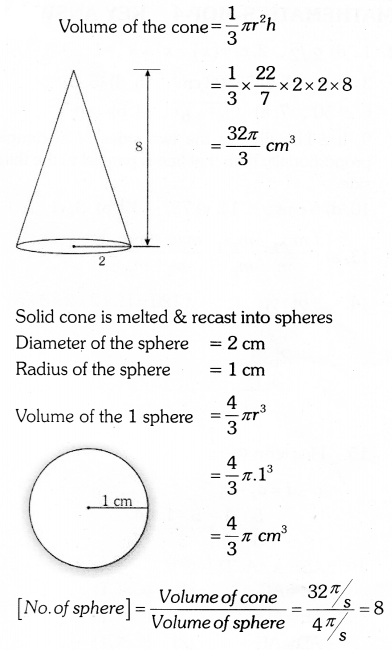
Karnataka State Syllabus SSLC Maths Model Question Paper 5 (Old Pattern)
Four alternatives are given to each question. Choose an appropriate answer. Write it along with its alphabet.
(1 × 8 = 8)
Question 1.
The distance between the points (2, 3) and (4, 1) is
(a) 3√2
(b) 2√3
(c) √2
(d) 2√2
Question 2.
The cubic polynomial among the following is
(a) p(x) = x2 – x – 2
(b) q(x) = 2x2 + x – 7
(c) r(x) = x3 + x2 – 1
(d) s(x) = x4 – x3 + x2 – 2
Question 3.
The probability of a certain event is
(a) 0
(b) 1
(c) \(\frac { 1 }{ 2 }\)
(d) \(\frac { 1 }{ 3 }\)
Question 4.
The volume of a sphere of radius 21 cm is
(a) 38808 cm3
(b) 80838 cm3
(c) 83808 cm3
(d) 88380 cm3
Question 5.
If y = x – 2 and x + y = 8, then the values of x and y are respectively,
(a) -5, 3
(b) -3, 5
(c) 3, 5
(d) 5, 3
Question 6.
In the adjoining figure, AB and AC are tangents from A. Then ABC =?
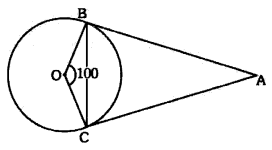
(a) 30°
(b) 40°
(c) 50°
(d) 60°
Question 7.
The distance between points (a, b) and (-a, -b) is
(a) \(2\sqrt { { a }^{ 2 }+{ b }^{ 2 } }\)
(b) \(\sqrt { { a }^{ 2 }+{ b }^{ 2 } }\)
(c) 2\(\sqrt { { a }+{ b } }\)
(d) \(\sqrt { { a }+{ b } }\)
Question 8.
The roots of the equation 2x2 – 200 = 0 are
(a) ±20
(b) ±10
(c) 20
(d) 10
(6 × 1 = 6)
Question 9.
State the converse of Basic proportionality theorem.
Question 10.
AB is a chord in a circle of radius 5 cms. OP ⊥ AB. If OP = 4 cms then AB = ……..
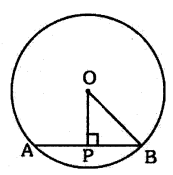
(a) 8 cm
(b) 10 cm
(c) 12 cm
(d) 6 cm
Question 11.
The product of HCF and LCM of two numbers is 75. Then the product of the numbers is
(a) 125
(b) 25
(c) 75
(d) 57
Question 12.
The zeroes of the Polynomial p(x) = x2 + 4x + 3 are
(a) -3, -1
(b) 1, 3
(c) -1, 3
(d) -3, 1
![]()
Question 13.
If a point P (x, y) divides the line segment joining, A (x1, y1) and B (x2, y2) in the ratio m1 and m2, then the coordinates of P are




Question 14.
Express 120 as a product of prime factors.
(16 × 2 = 32)
Question 15.
Write the first term and common difference for the following A.P.
\(\frac { 1 }{ 3 }\) , \(\frac { 5 }{ 3 }\) , \(\frac { 9 }{ 3 }\) , \(\frac { 13 }{ 3 }\) , ……..
Question 16.
In the figure of ∆ABE = ∆ACD show that ∆ADE ~ ∆ABC
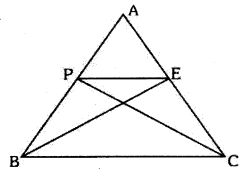
Question 17.
Solve for x and y
3x + 2y = 3
2x + 3y = 2
Question 18.
If twice the son’s age is added to the age of his father the sum is 90. If twice the father’s age is added to the age of the son the sum is 120. Find their ages.
Question 19.
In the figure given O is the centre of the bigger circle and AC is its diameter. Another circle with BA as the diameter is drawn.
If AC = 54 cms & BC = 10 cms. Find the area of the shaded region.

Question 20.
Construct a tangent of length 4 cm. from an external point to a circle of radius 3 cms.
Question 21.
Find the relation between x and y, such that the point (x, y) is equidistant from the points (3, 6) and (-3, 4).
Question 22.
Prove that 7 + √5 is irrational.
Question 23.
Find the quadratic polynomial, whose zeroes are (2 + √3) and (2 – √3)
Question 24.
Find a cubic polynomial with the sum, sum of the product of its zeroes taken two at a time & product of its zeroes as 2, -7, -14 respectively.
Question 25.
Solve the equation 2x2 – 5x + 3 = 0 using formula.
Question 26.
Evaluate:

Question 27.
From the top of a 7 m high building, the angle of elevation of the top of a tower is 60° & the angle of depression of its foot is 45°. Find the height of the tower.
Question 28.
From the top of a lighthouse, the angles of depression of two ships on the opposite sides of it are observed to be 30° and 60°. If the height of the lighthouse is h mts & the line joining the ships passes through the foot of the lighthouse find the distance between the ships.
Question 29.
A lot of 20 bulbs contains 4 defective ones, one bulb is drawn at random from the lot. What is the probability that the bulb is defective?
Question 30.
The sum of the radius of base and height of the solid right circular cylinder is 37 cms. If the total surface area of the solid cylinder is 1628 cm2. Find the volume of the cylinder.
(6 × 3 = 18)
Question 31.
A line drawn through the end point of a radius and perpendicular to it is a tangent to the circle. Prove this.
Question 32.
Draw a line segment of length 4.5 cms and divide it is the ratio 3 : 6 & measure each part.
Question 33.
Pocket money of A and B are in the ratio 6 : 5 & the ratio of their expenditure are in the ratio 4 : 3. If each of them saves Rs. 50 at the end of the month find their pocket money.
OR
The sum of a two-digit number & the no. obtained by reversing the digits is 99. If the no. obtained by reversing the digits is 9 more than the original no. find the no.
Question 34.
If tan2A = cot (A – 18°) where 2A is an acute angle, find A.
OR
Show that tan 48°. tan 23°. tan 42 °. tan 67° = 1
Question 35.
Calculate the median for the following data.
| C.I. | f |
| 1500 – 2000 | 14 |
| 2000 – 2500 | 50 |
| 2500 – 3000 | 60 |
| 3000 – 3500 | 86 |
| 3500 – 4000 | 74 |
| 4000 – 4500 | 62 |
| 4500 – 5000 | 48 |
OR
Calculate the mode for the following data.
| C.I. | f |
| 150 – 155 | 12 |
| 155 – 160 | 13 |
| 160 – 165 | 10 |
| 165 – 170 | 8 |
| 170 – 175 | 5 |
| 175 – 180 | 2 |
Question 36.
Contant OGIVE for the following distribution.
| C.I. | f |
| 50 – 60 | 6 |
| 60 – 70 | 5 |
| 70 – 80 | 9 |
| 80 – 90 | 12 |
| 90 – 100 | 6 |
(4 × 4 = 16)
Question 37.
If the 3rd and 9th terms of an A.P. are 4 and -8 respectively, which term of this AP is zero?
OR
If (2n + 3) is the nth term of an A.P. find (i) first term, (ii) common difference, (iii) 15th term.
Question 38.
Prove that in a right-angled triangle, the square as the hypotenuse is equal to the sum of the squares on the other two sides?
Question 39.
Solve the following in graphically:
3x – y = 3
2x + y = 2
Question 40.
The cost of painting the total outer surface of a closed cylindrical tank at 60 per square cm. is Rs. 237.60. The height of the tank is 6 times the radius of the base. Find the height & radius of the tank.
Solutions
Solution 1.
(d) 2√2
Solution 2.
(c) r(x) = x3 + x2 – 1
Solution 3.
(b) 1
Solution 4.
(a) 38808 cm3
Solution 5.
(d) (5, 3)
Solution 6.
(c) 50°
Solution 7.
(a) \(2\sqrt { { a }^{ 2 }+{ b }^{ 2 } }\)
Solution 8
(b) ±10
Solution 9.
If a line divides the two sides of a triangle proportionally then that line is parallel to the third side.
Solution 10.
(d) 6 cms
Solution 11.
(c) 75
Solution 12.
(a) (-3, -1)
![]()
Solution 13.

Solution 14.

Solution 15.
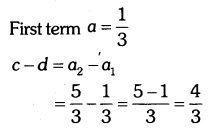
Solution 16.
ΔABE = ΔACD (data)
AB = AC …… (1) (CPCT)
AE = AD (CPCT)
⇒ AD = AE ….. (2) (CPCT)
Dividing (1) & (2)
\(\frac { AB }{ AD }\) = \(\frac { AC }{ AE }\) …..(3)
also DAE = BAC ….. (4) (Common angle)
From (3) & (4)
ΔADE ~ ΔABC (SAS Similarity criterian)
Solution 17.
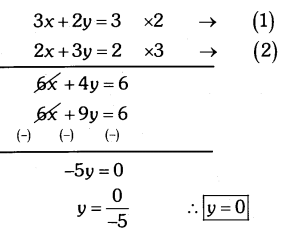
Substitute the value of y in equation (1)
3x + 2y = 3
⇒ 3x + 2(0) = 3
⇒ 3x + 0 = 3
⇒ 3x = 3
⇒ x = 1
∴ x = 1, y = 0
Solution 18.
Let the age of father = x years
Let the age of the son = y years
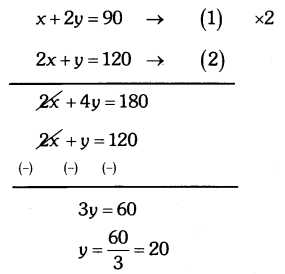
Substitute the value of y in equation 1
x + 2y = 90
⇒ x + 2(20) = 90
⇒ x + 40 = 90
⇒ x = 90 – 40 = 50
Age of the father = 50 years
Age of the son = 20 years
Solution 19.
Area of the shaded region = Area of the circle with AC as diameter – Area of the circle with AB as the diameter
Area of the shaded region
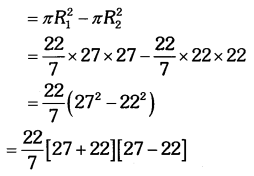
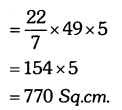
Solution 20.
Draw the rough figure & calculate OA using Pythagora’s theorem. Then construct the tangent.
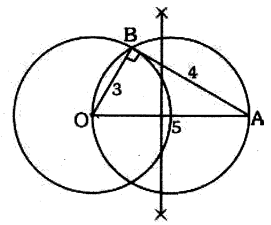
Solution 21.
Let P → (x, y)
A → (3, 6) & B → (-3, 4)
PA = PB (data)
PA2 = PB2
(3 – x)2 + (6 – y)2 = (-3 – x)2 + (4 – y)2
⇒ 9 + x2 – 6x + 36 + y2 – 12y = 9 + x2 + 6x +16 + y2 – 8y
⇒ -6x + 36 – 12y = 6x + 16 – 8y
⇒ -12x – 4y + 20 = 0 (÷4)
⇒ 3x + y – 5 = 0
This is required relation.
Solution 22.
Let us assume that 7 + √5 is rational
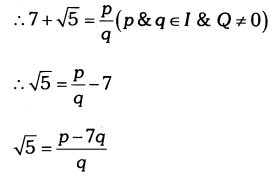
RHS is rational
⇒ LHS is also rational but √5 is irrational.
It is contradictory to the fact that √5 is irrational.
our assumption is wrong
7 + √5 is irrational
Solution 23.
S = Sum of the zeros = 2 + √3 + 2 – √3 = 4
P = Product of the zeroes = (2 + √3)(2 – √3) = 4 – 3 = 1
The required quadratic polynomial is
k[x2 – Sx + P] where ≠ 0 is real
⇒ k[x2 – 4x + 1]
Solution 24.
Let α, β & γ be the zeroes of the required cubic polynomial
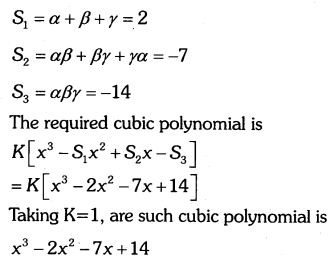
Solution 25.
2x2 – 5x + 3 = 0
It is in the form ax2 + bx + c = 0
a = 2, b = -5, c = 3
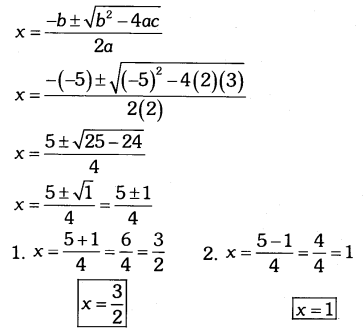
Solution 26.
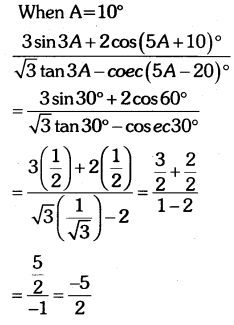
Solution 27.
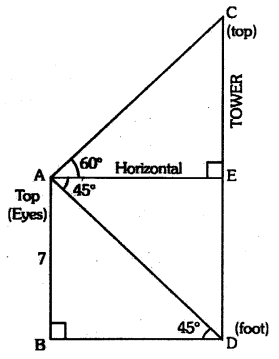
In the Rt. angled ΔABD
tan 45° = \(\frac { AB }{ BD }\)
1 = \(\frac { AB }{ BD }\)
BD – AB = 7m
AE = 7m
In the Rt. angled ΔAEC
tan60° = \(\frac { CE }{ AE }\)
√3 = \(\frac { CE }{ 7 }\)
CE = 7√3
Height of the tower = CD
= DE + CE
= AB + CE
= 7 + 7√3
= 7(√3 + 1)
![]()
Solution 28.
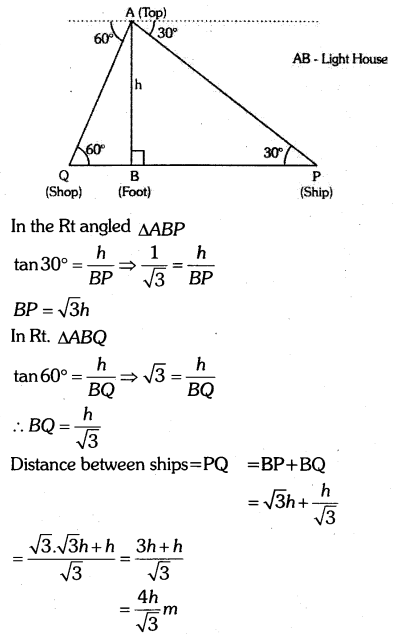
Solution 29.
Total no. of bulbs = 20
No. of all possible outcomes = 20
Let E1 be the event that the bulb-drawn at random from the lot is defective
No. of outcomes favourable to E1 is 4 Since there are 4 defective bulbs.

Solution 30.
r + h = 37
T.S.A. of the cylinder = 2πrh + 2πr2 = 2πr (h + r)
But 2πr (h + r) = 1628
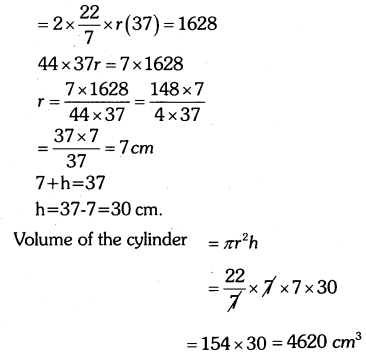
Solution 31.
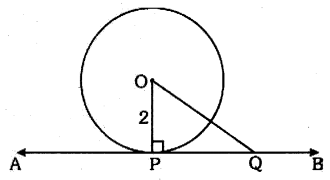
Data: A radius OP of a circle is drawn. Through the circle is drawn. Through the end point P of this radius a line AB is drawn the perpendicular to radius OR
To prove: AB is a tangent to the circle at P
Proof: Let Q be any point different from P on this line.
Now OP ⊥AB (data)
OP is the shortest of all the distances from the point O to the line APB.
OP < OQ ⇒ OQ > Radius OP
Q is an exterior point of the circle i.e. Q lies outside the circle, for all positions of Q different from P
Line AB meets the circle only at the point P Line AB is a tangent to the circle at P
Solution 32.
AC : CB = 3 : 6
AB = 4.5 cms.
AC = 1.5 cms
CB = 3 cms.
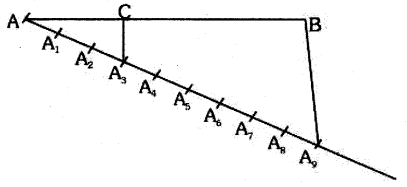
Solution 33.
Let the pocket money of A and B respectively = 6x and 5x
Let their expenditure be 4y and 3y respectively.
Monthly savings of A and B = (6x – 4y) & (5x – 3y)
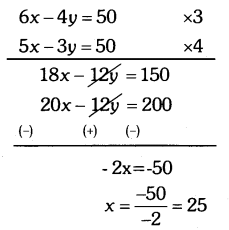
The pocket money of A = 6x = 6 × 25 = Rs. 150
The pocket money of B = 6x = 5 × 25 = Rs. 125
OR
Let the two digit no. be yx = 10y + x
as reversing the digits it becomes 10x + y
10y + x + 10x + y = 99
⇒ 11x + 11y = 99
⇒ x + y = 9 …….. (1)
According to the second condition
10x + y = 10y + x + 9
⇒ 9x – 9y = 9
⇒ x – y = 1 ……… (2)
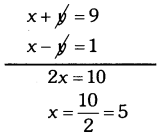
Substitute the value of x in equation (2)
x – y = 1
⇒ 5 – y = 1
⇒ y = 4
The required no. is yx = 45
Solution 34.
tan 2A = cot (A – 18°)
cot(90 – 2A) = cot( A – 18) [∴ tan θ = cot (90 – θ)]
90 – 2A = A – 18
90 + 18 = A + 2A
108 = 3A
A = 36°
OR
LHS = tan 45° tan 23° tan 42° tan 67°
= tan(90 – 42) tan 23° tan 42° tan(90 – 23°)
= cot42° tan 23° tan 42° cot 23°

Solution 35.
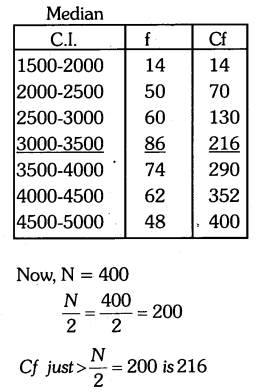
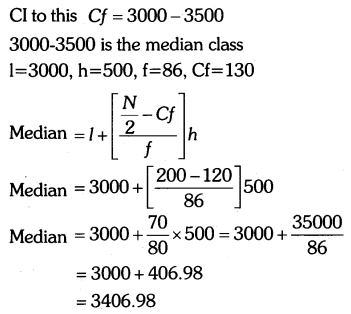
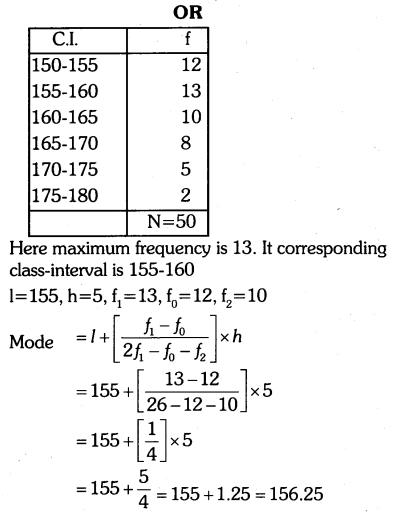
Solution 36.
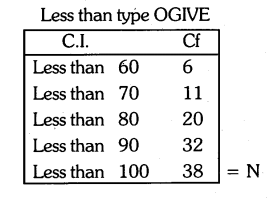
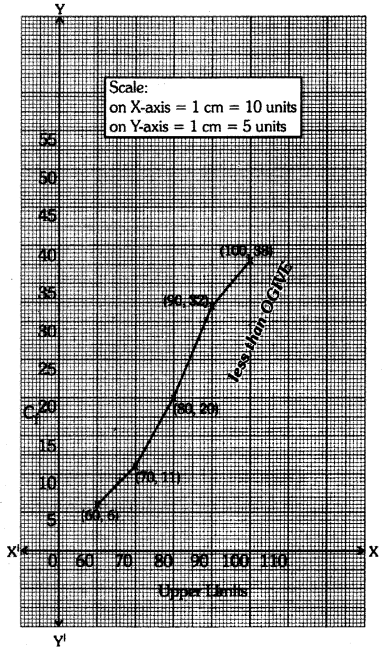
Solution 37.
Let the first term and common difference of the AP be a and d respectively.
T3 = 4 ⇒ a + 2d = 4 …… (1)
T9 = -8 ⇒ a + 8d = -8 ……. (2)
Solving Equation 1 & 2
d = -2
Substitute the value of d in equation 1
a + 2d = 4
⇒ a + 2(-2) = 4
⇒ a – 4 = 4
⇒ a = 8
Let the nth term be zero
Tn = 0
a + (n – 1)d = 0
⇒ 8 + (n – 1)(-2) = 0
⇒ 8 – 2n + 2 = 0
⇒ 10 – 2n = 0
⇒ 10 = 2n
⇒ n = 5
5th term of the AP = zero
OR
a. an = 2n + 3
put n = 1
a1 = 2(1) + 3
⇒ a1 = 5
first term = 5
Put n = 2
b. a2 = 2(2) + 3
⇒ a2 =4 + 3
⇒ a2 = 7
d = a2 – a1
⇒ d = 7 – 5
⇒ d = 2
Common difference = 2
c. Tn = (2n + 3)
Put n = 15
T15 = 2(15) + 3 = 30 + 3 = 33
Fifteenth term = 33
Solution 38.
data: ABC is a ∆ in which B = 90°
To Prove: AC2 = AB2 + BC2
Construction: Draw BD ⊥ AC
Proof: In ∆ABC and ∆ABD
A is common
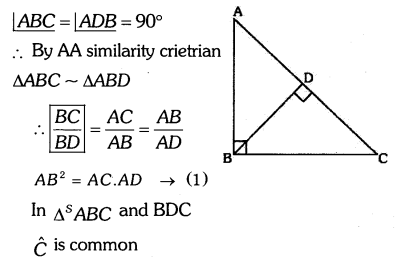
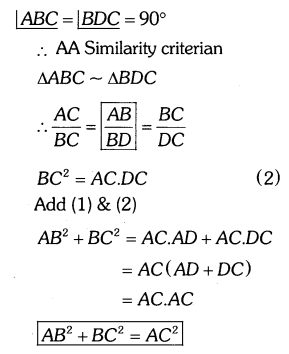
Solution 39.
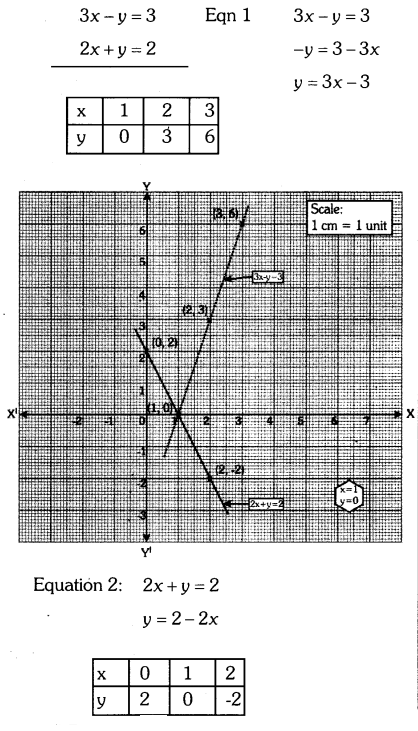
![]()
Solution 40.
